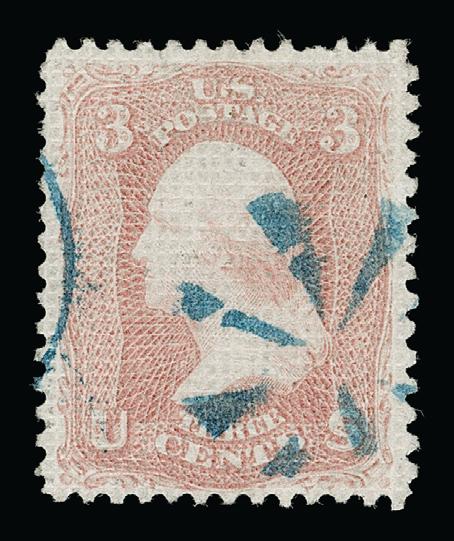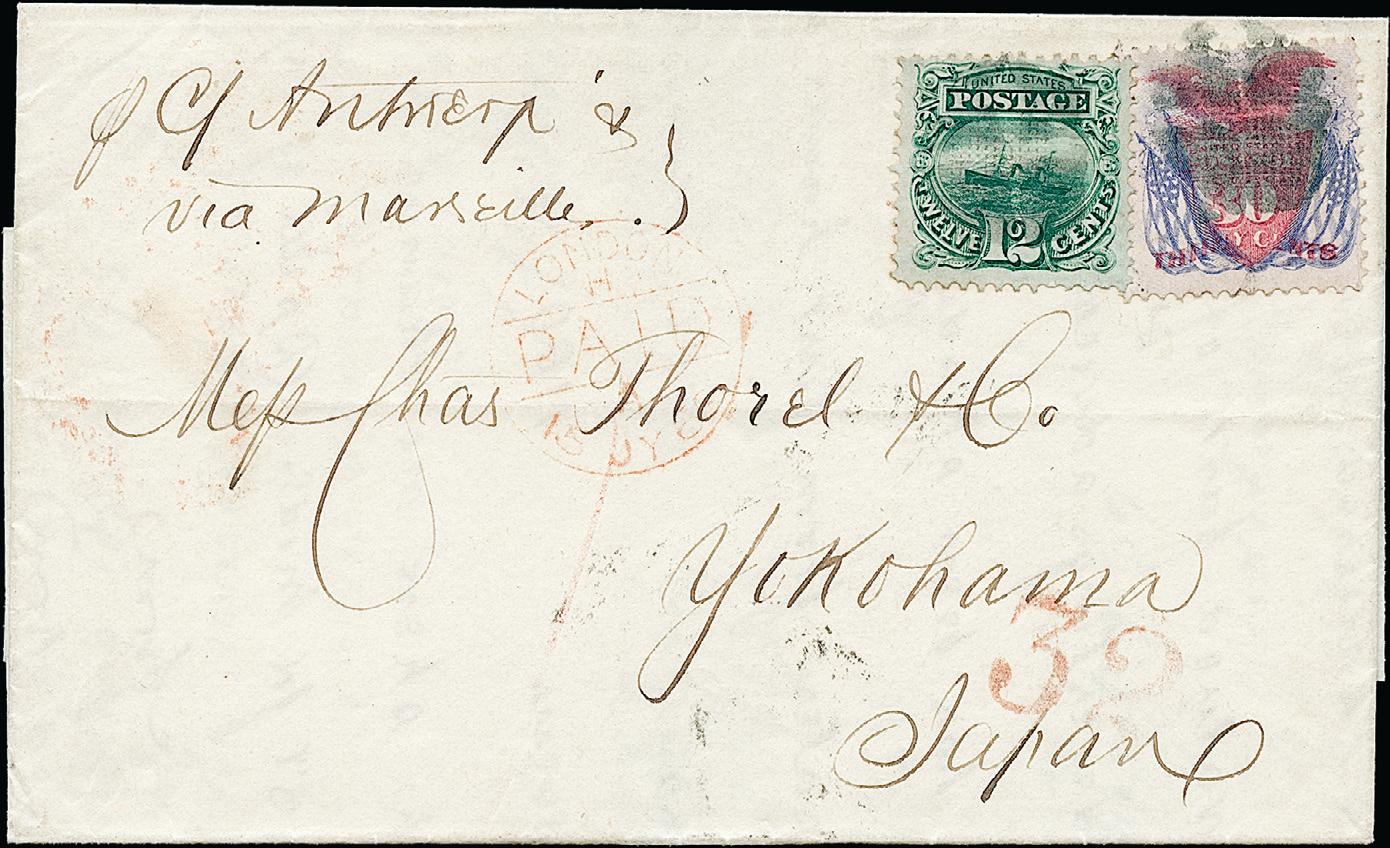

Japan: The “Meiji” Property including The Grand Prix Collection


The
“I consider this stamp the most valuable in Asian philately, and for an Asian collector like myself, the most valuable stamp in the world. I would have paid any price to obtain it”. Ryohei Ishikawa
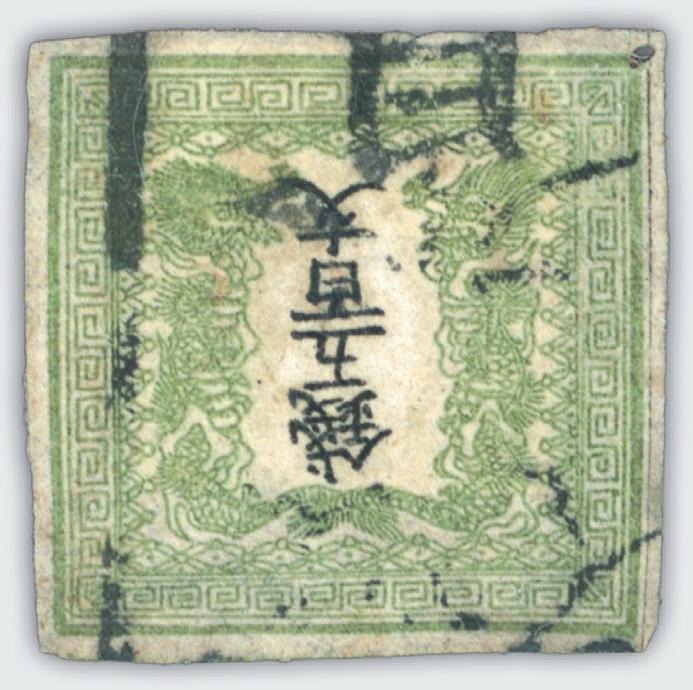
 David Feldman International Auctioneers
David Feldman International Auctioneers
Editor: Wayne L. Youngblood wystamps@gmail.com
Layout and Design: Jason E. Youngblood jyoungblood@gmail.com
Publications Committee:
John Barwis, RDP
Robert
James Grimwood-Taylor, RDP
Matthew Healey
Daniel M. Knowles, MD
Robert P.
Advertising Manager: Robert Gray robertgray@me.com
Book Review Editor: Dr. Luca Lavagnino, Europe
Editorial Correspondence: wystamps@gmail.com
Business Correspondence: 11 W 42nd St FL2, New York NY 10036-8008 Tel. (212) 683-0559
email: info@collectorsclub.org
Website: www.collectorsclub.org
Executive Secretary and Librarian: Andrea Matura collectorsclub@collectorsclub.org
Authors’ guidelines for the CCP are available from the editor.
May-June 2023
Volume 102, Number 3
The Collectors Club Philatelist
1856-1864: Unlocking the Mystery of District
The Collectors Club Philatelist (ISSN 0010-0838) is published bimonthly in January, March, May, July, September and November by The Collectors Club, 11 W 42ND ST FL2, NEW YORK NY 10036-8008 A subscription to The Collectors Club Philatelist is included with dues paid by members of The Collectors Club. Subscription price for nonmembers in the United States is $70. Prices for foreign addresses and/or other classes of mail are higher depending on actual cost; consult publisher. Subscriptions for outside the United States should be paid in U.S. funds drawn on a U.S. bank. Back issues $9, including postage. For a complete list, write the publisher. Claims for undelivered issues will be honored only within six months ofthe date of publication. Beyond that, replacements will be provided at the single copy price. Periodicals class postage paid at New York, New York 10001 and additional offices. Office of Publication: The Collectors Club, 11 W 42ND ST FL2, NEW YORK NY 10036-8008 Copyright@ 2023 by The Collectors Club. All rights reserved. We do not give implied or other consent for copying for more than personal use.
Indexed in PhiLindx by E.E. Fricks and included in the article index of the American Philatelic Research Library and the Global Philatelic Library. The opinions and statements contained in the articles are those of the authors and not necessarily those of The Collectors Club, its officers or staff
Club Philatelist
POSTMASTER: Send change of address to:
The Collectors Club Philatelist, 11 W 42ND ST FL2, NEW YORK NY 10036-8008
Volume 102, Number 3
129
THE COLLECTORS CLUB
11 W 42ND ST FL2, NEW YORK NY 10036-8008 (212) 683-0559
The Collectors Club is open Monday through Friday, 10 a.m. to 5 p.m. Please call ahead if intending to visit.

Officers
President Lawrence Haber
Vice President
Secretary
Robert Gray
Matthew Healey
Treasurer Roger S. Brody, RDP Chief Technology Officer
Class of 2023
Roger S. Brody, RDP
Vincent Cosenza
Joan Harmer
Kathryn Johnson
Behruz Nassre
Governors
Joan Harmer
Class of 2024
Ozan Gurel
Mark E. Banchik
Lawrence J. Hunt
Stephen Reinhard
Robert G. Rose
Class of 2025
Robert Gray
Lawrence Haber
Matthew Healey
Daniel J. Ryterband
Wade E. Saadi, RDP
The Collectors Club Philatelist is an international specialty journal serving the needs of hundreds of collectors worldwide. It serves as the journal of record for the Collectors Club as well as publishing stimulating and helpful articles for collectors of many levels and specialties. The Collectors Club Philatelist strives to publish accurate philatelic information and serves as a forum for communication among members of the Collectors Club.
President’s Message
Lawrence Haber

Doubtless, you have already noticed you received an extra “bonus” with this issue of the Collectors Club Philatelist . We are very pleased to publish this monograph on the New Sweden Colony, by John Barwis. We hope you enjoy reading this important work. But, our aspirations go beyond this particular work.
One of the elements that distinguishes philately from many, if not most, other hobbies is our emphasis on research and the printed word. A mere cursory look at this Club and many others reveals the size and extent of our libraries. Also, our personal libraries are frequently nontrivial. As part of our ongoing move, we measured the size of our library with care and discovered that it requires almost 4,000 linear feet (1.25 km) of shelf space. Our hobby is no stranger to the wri tt en word. But what concerns many of us is the depth and breadth of research that never reaches an audience. Much research remains trapped in the notes of the collector/exhibitor and is never shared. We view this as a tragedy since, in all probability, if not published, it will be lost.
So, why the monograph? Why this particular medium? The answer is really quite straightforward. Article-length pieces have multiple venues to reach the public. Our hobby does not lack journals. There may be a question about which journal is best suited to publish a piece, but there is a wide variety of journals out there and much to choose from. But frequently, the work requires greater length. How about a book? The di ffi culty here is that bringing a book to print is a complex endeavor, and distribution is a challenge. Although there are many print-by-demand options, the cost of editing, composition and printing are not insubstantial hurdles. Also, length can be a question mark. Works extending longer than 100 pages deserve the full-length treatment a book dictates, but what if our length is shorter than 100 pages? And how do we achieve distribution? Ge tt ing a work out there to be purchased and read is a real problem. And I do not wish to sha tt er any illusions out there, but a philatelic book that achieves sales of 200 units is a best seller. Yes, it does get you into the card catalog, but you need a readership.
We believe that this monograph series is an ideal solution. It is notably cheaper to produce and deliver. By being sent out with our regular CCP issue, its sales make it a best seller. And isn’t that the point? To get the work out there, into the hands of other philatelists to be read and appreciated – and entered into the card catalog, thereby preserving all the hard work behind it – is a de fi nite service and achievement.
So, beyond reading and appreciating John’s work here, we hope that this inspires you to consider adding your name to the list of authors of our new, revived monograph series.
Although it may seem some ways o ff , we encourage you to join us at the annual Great American Stamp Show in Cleveland, Ohio, from Aug. 10-13. As has been our usual practice, we will share a table with our friends from the Philatelic Foundation. We hope to see you there.
We also encourage you to consider nominations for the Alfred F. Lichtenstein Memorial Award for Distinguished Service to Philately. Instructions and forms for nominations can be found on our website. Now is the time to prepare a nomination for a well-deserving individual. We expect to schedule our Lichtenstein dinner to coincide with the opening events for our new Clubhouse.
Those of you who closely follow our masthead will notice a new name. We want to welcome Behruz Nassre to the Board of Governors. He fi lls the seat previously held by the late Lou Pataki. In addition to serving as our program commi tt ee chair, Behruz is an extraordinary collector/exhibitor of pre-1925 Persia. He is a Bay-Area high-tech executive in his spare time, when not taking a leading role in many philatelic organizations, including the Iran Philatelic Study Circle, the Collectors Club of San Fransisco, the UPSS, the Royal and the Society of Postal Historians. In addition, he is the current head of the Westpex stamp show. As his background portents, he will surely be an excellent addition to our board.
No, we have not forgo tt en about our new Clubhouse. We have an overview of where we stand in designing our new home beginning on page 136 in this issue. We encourage you to have a look.
Keep up to date with what’s happening in your Club:
www.collectorsclub.org
Editor’s Notepad
Wayne L. YoungbloodWell, It’s Official ...
As you may well have seen by now, there is at least a second partial pane of the $1 Candleholder Invert of the Ameriana series (dubbed the “CIA Invert”) known to exist. I broke this story May 1, first in the online version of Linn’s Stamp News and, later, in the print version of the newspaper.

After more than 35 years of hoping and speculation, a plate block, taken from the plate strip shown at far right, appeared on the eBay e-commerce site with what might be considered the steep price of $199,000, which was later amended to $225,000. Given that this may well be the only plate block to appear, that’s probably not an unreasonable price, but the value of singles could be affected.

First, there’s no way this plate block could possibly have come from the discovery pane from 1986. As you can clearly see, this plate block has a telltale vertical wide white line that runs the length of the strip. The largemargin plate strip was on the right side of the CIA pane, with no line present.
If you were to orient this block by the position of the lineengraved intaglio plate number, this would be from an upper-left pane (from a press sheet of 400). The pane discovered by Central Intelligence Agency employees in 1986 was from the upper-right
position (again, as oriented by plate number), but the plate number had been destroyed before the pane was purchased. All so-called “white line” examples came from the left side of the pane, which didn't include any marginal markings. In addition, that white line was a narrow one (reflecting the narrow space between panes on the printing sheet), with the tan background appearing again at the edge of the stamp, as shown in the nearby image, courtesty of Robert A. Siegel Auction Galleries.
This, of course, bears no resemblance to the wide white line present on the newly discovered examples.
Actually, “newly discovered” for this second pane is a bit of a misnomer. As it turns out, the existence of these additional inverts has been known since at least 2018, when the plate strip was offered to a collector at a show in Columbus, Ohio (when the photo was taken). What is not yet known is whether the entire pane survived or just the plate strip. My money is on the entire pane, and it is likely that several singles have been sold at auction over the past few years.
When the Candleholder Invert first appeared, I attempted to track the position of each example sold, when it sold and by what auction house. That way, if any new examples (such as these) turned up, they would be easily identified. This is a pursuit I finally gave up several years ago, but because these stamps were processed on an L perforator, the perforation pattern of each is identifiable, providing positive identification as to from which pane an invert originated.
Is anyone interested in continuing to track these inverts and from which pane they originated? It could be an interesting study.
Collectors Club Programs 2023
June 7 Ottoman Railway Postal History, Dr. Atadan Tunaci
June 21 Steamboat Mail and the 1847 Issue, Dan Ryterband
Sept. 6 Touch Me, Feel Me, Smell Me, Scratch Me, Taste Me, Plant Me, Hear Me, Ross Towle
Sept. 20 The Frontier Wars – South Africa, Jan Hofmeyr
Oct. 4 Our Hobby’s Future
Oct. 18
Nov. 1
Nov. 15
Dec. 13
Rhodesia Missionary Mail, Mark Loomis
NYC Foreign Mail, Nick Kirke
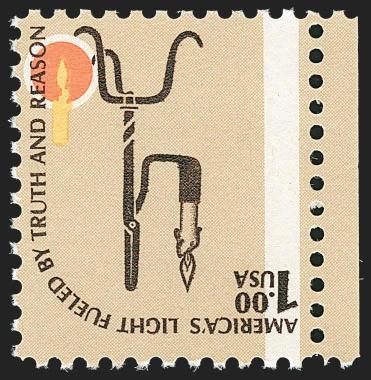
FAM 22, Gordon Eubanks
Denmark, Birthe and Chris King
More details found at www.collectorsclub.org/events
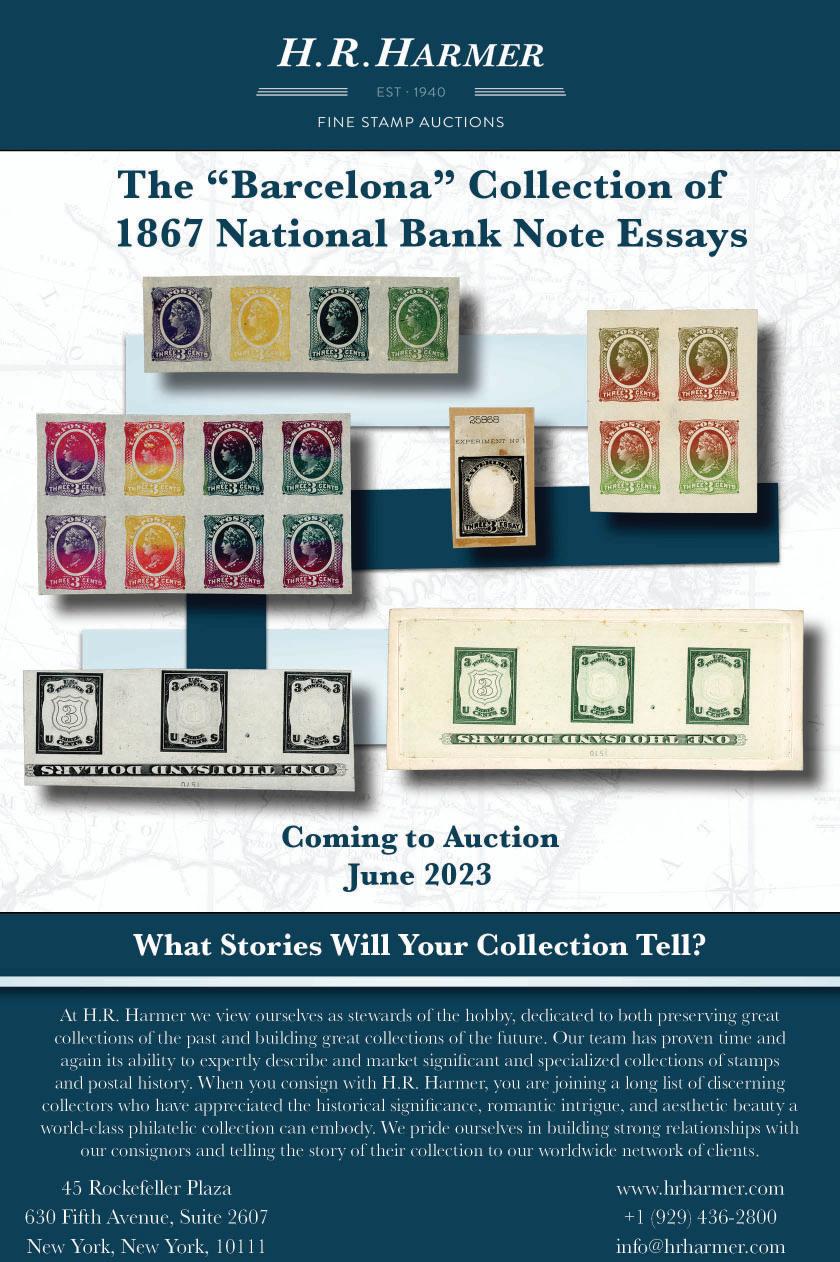
Clubhouse Updates
Lawrence HaberWe would like to update you on the progress we have been making in establishing our new Clubhouse at 58 West 40th Street. We are very excited to have reached this stage where we can share images of our new home. I am personally really "taken" by the design. Looking at the drawings accompanying this update, you can start to project yourself into the spaces and imagine life in our new premises. It reminds us how much we are looking forward to our new Clubhouse. It should also be mentioned that we have benefited from the fabulous advice of our architects and other design professionals. All this serves to reaffirm that our future is bright and ambitious.
As you may recall, we have entered into a long-term lease for space at 58 West 40th Street. This location is between Fifth and Sixth Avenues, across from Bryant Park and diagonally across from the New York Public Library. We will occupy the entirety of the second-floor mezzanine, the only tenant on the floor. The building dates to the 1920s, rises to more than 20 stories and provides all the modern requirements you would expect. The floor is serviced by three elevator cabs, and there are no physical obstacles for any of our members.
But, before going further, we should point out the following:
• We are looking at a new vision for our Clubhouse. We are not looking to recreate the past. That would be a foolhardy objective. We are on the cusp of the second quarter of the 21st century, and this reality is reflected in the design. We also recognize that our Clubhouse is in New York, and New York is a modern city that faces the future with enthusiasm. Our design reflects that enthusiasm for the future.
• The design reflects our needs, not the constraints of a pre-existing form. We started with a blank canvas. The floor is delivered to us empty of design or construction elements beyond a floor, a ceiling and the exterior walls. We considered our needs and how we use our Clubhouse, and the design was developed in response to those needs. Our needs are driving the design, not a pre-existing fixed structure.
• We want to maximize our flexibility. We envision large and small meetings. We see the Clubhouse being used by members from both out of town and in town to visit an oasis within a busy city, a premier research library, and a meeting place.
Remember ...
When buying material from advertisers, please let them know you saw their ad in the CCP. They support both the hobby and your journal!
Shown in Figure 1, we have the overall floor plan. One would enter from one of the elevators, and the option is to turn left or right. If you turn right, you will enter the lounge. The lounge has flexible seating with a variety of conversation sites. The seating here will also accommodate small-scale meetings. The lounge has a set of large windows that run the entire floor width and are floor-to-ceiling. These overlook Bryant Park. The lounge is immediately adjacent to our large meeting room. The meeting room has a capacity of over 40; we will install new, custom-made frames on both sides of the meeting room. In the meeting room, as will be the case throughout, the utmost in technology will imbue the entirety of our space. The chairs in the meeting room can be repositioned or stacked, providing us with a great deal of flexibility.




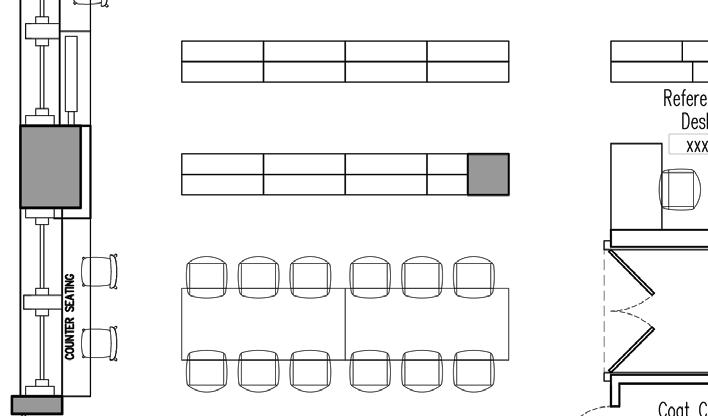



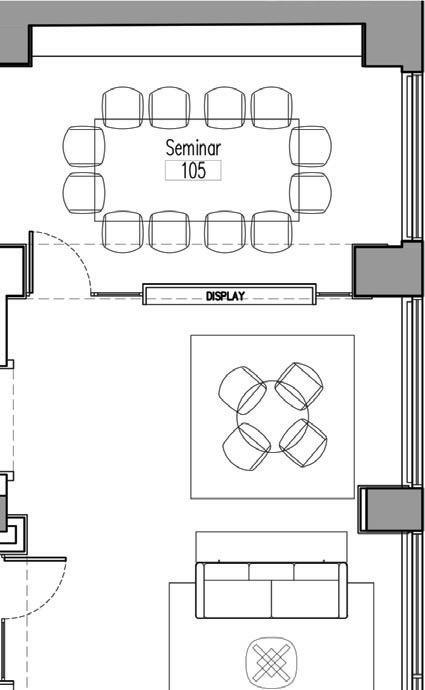

Also, adjacent to the lounge, you will find a seminar room ideally suited for intermediate-sized meetings. The meeting and seminar rooms will have video monitors and can host virtual or hybrid meetings.

Returning to the elevator lobby, you will enter the library on the left. Most prominently, we have a large library table as you enter. The table is adjacent to our open stacks. Again, the library table will provide a fabulous place for collectors to meet and discuss philatelic matters. The exterior wall has double-hung windows, and against this wall will be short-shelf desks. These will be ideal for researchers. A copy and scanning position and the entrance to our high-density shelving will be at the back of the room. We also have made provisions for storing our rare book collection separately and securely.



Three restrooms, a pantry, and storage will run across the back of the floor.
Let’s consider how we expect to use our space: meetings, large and small, research in our library, and connecting with other collectors. We think this design is intended to help us fulfill these needs.


Please understand that this design is not yet final, there will be changes, but this gives our membership a glimpse of what the future holds.
All Collectors Club presentations are currently held online, via ZOOM, beginning at 5:30 p.m. (Eastern). Although there is no cost, pre-registration is necessary.

Essential Elements
Ghosts of the Postal Past
 Richard A. Coffey
Richard A. Coffey
Recently, after spending many days contemplating the profundities of a folded letter, I began to believe that I was developing a sixth sense. I was feeling the presence of entities that cannot be described by our usual five senses – especially after dinner when I had retired to my stamp room. I shouldn’t be surprised. Our folded letters, covers and stamps have survived their original owners and landed in our possession more than a century later, manifesting an essence of sorts.
My wife suggested that I cut back on chicken curry, which solved the problem immediately, but then left me thinking about the legacy – the remains of postal events.
Postal historians study remains. We study the paper, the ink, the cursive script, postal markings, private markings, stamps and content. The authors and enablers of our postal history, however long deceased, will often come alive when we write about the cover. When we expose the timeless nature of the piece, we show how the past and the present converge. Our job is to reveal the cover’s history and show how it is antecedent, yet contemporary to our own.
The three- by five-inch folded letter shown in Figure 1 represents a nanosecond in the evolution of letter mail, a moment in the 5,000-year history of mankind’s compulsion to communicate, to exchange news, to shout into the silence of time and to be heard.
The letter illustrates the moment in history before cheap postage and before the invention of stamps. It was written in 1836, the year Davy Crockett died at the Alamo. It was addressed to a young man who was destined to become one of America’s talented landscape painters, W.T. Russell Smith. Russell, as he was called in those days, was working a gig at the Lions Theatre in Boston, painting background scenery. The letter writer, a Philadelphian who may have been an uncle, was expounding in the fashion of the times: laboriously cheerful about having received a recent letter from Russell and precisely dictatorial about how young Russell might improve his prospects in Boston.
Letters, like newspapers, were hallowed culture in the 19th century. People were on the move worldwide in search of profitable prospects while feudalism faded. Better roads made it possible, increasing literacy made it feasible and, soon, families that once farmed together became separated and contingent upon postal service to bind their ties.
In America, uprooted immigrants leapfrogged from se ttlement to opportunity. Unfe ttered, though lonely, the newcomers found solace in newspapers and le tters from home. So great was the need to connect that people took pride in creating le tters. It was considered an art to pen readable cursive; round hand calligraphy gave way to the greater clarity of copperplate and the Spencerian hand taught in Victorian-age schools was replaced by the Palmer Method in the 20th century.
Machine-made paper replaced hand-made paper in the 1830s, spurred by growing demand for stationery. The steel point pen replaced the quill, roads improved,
Time proven Showgard® Mounts...
–Showgard Mounts are the choice and recommendation of experienced collectors. –For over 25 years Showgard Mounts have proven perfectly safe for stamps under every climatic condition in all parts of the world.
–It is a philatelic fact that collectors switch to Showgard Mounts as they gain in experience. It’s a sensible idea to start and save with Showgard Mounts. At dealers everywhere. Available with Dark Display or clear see-through background.

For Free Sample and Size Gauge
Please Write
Showgard House
115 North Route 9W
Congers, NY 10920
coaches improved and steam replaced the horse. The old frontier was slipping out of sight and the future of America was still hidden in the adventures of western expansion.
Unfold the letter and you’ll find a nine- by16-inch piece of lightly colored writing paper that affords three eight- by nine-inch writing fields, one panel for postscripts and space for an address. The folded letter weighs a mere five grams. The author had intended to forego postal service and send the letter with his friend, Dr. J.C. Flagg, whose “kindness” offered to carry the letter and the newspaper from Philadelphia to Boston, as noted on the cover’s lower left. But a postscript in the content says that on the morning of the 5th, Doc Flagg left for Boston without the letter. The writer hastily crossed out the directive and hustled to the Philadelphia post office, where he deposited the letter in the mails – noted by the reddish octagonal stamp: "PHILa 5 OCTr." The folded letter was rated 18¾¢ for a singleweight letter, based on the postal act of 1825, which modified a previous rate of 18¼¢ for the 150-400-mile distance. The increased rate was approved because a common coin of the realm in 1830 America was the Spanish dollar, for which 1 real equaled 12½¢ and ½ real equaled 6¼¢ or,18¾¢ for 1½ reales.
Postal markings tell us who, what, where and when, but it’s the content, the ghosts themselves, that tell us why and it is as reassuring today as it was a century ago to read the human voice, whether in despair or joy for these are stories about us.
Did you know... ...that there are many CC meeting presentations available to members on our website?
www.collectorsclub.org
You don't have to live in Manhattan to be an active, involved and happy member of the Collectors Club. This is just one of the many, many member resources available to you!
Please spend some time exploring this great Club website!
You'll be glad you did...

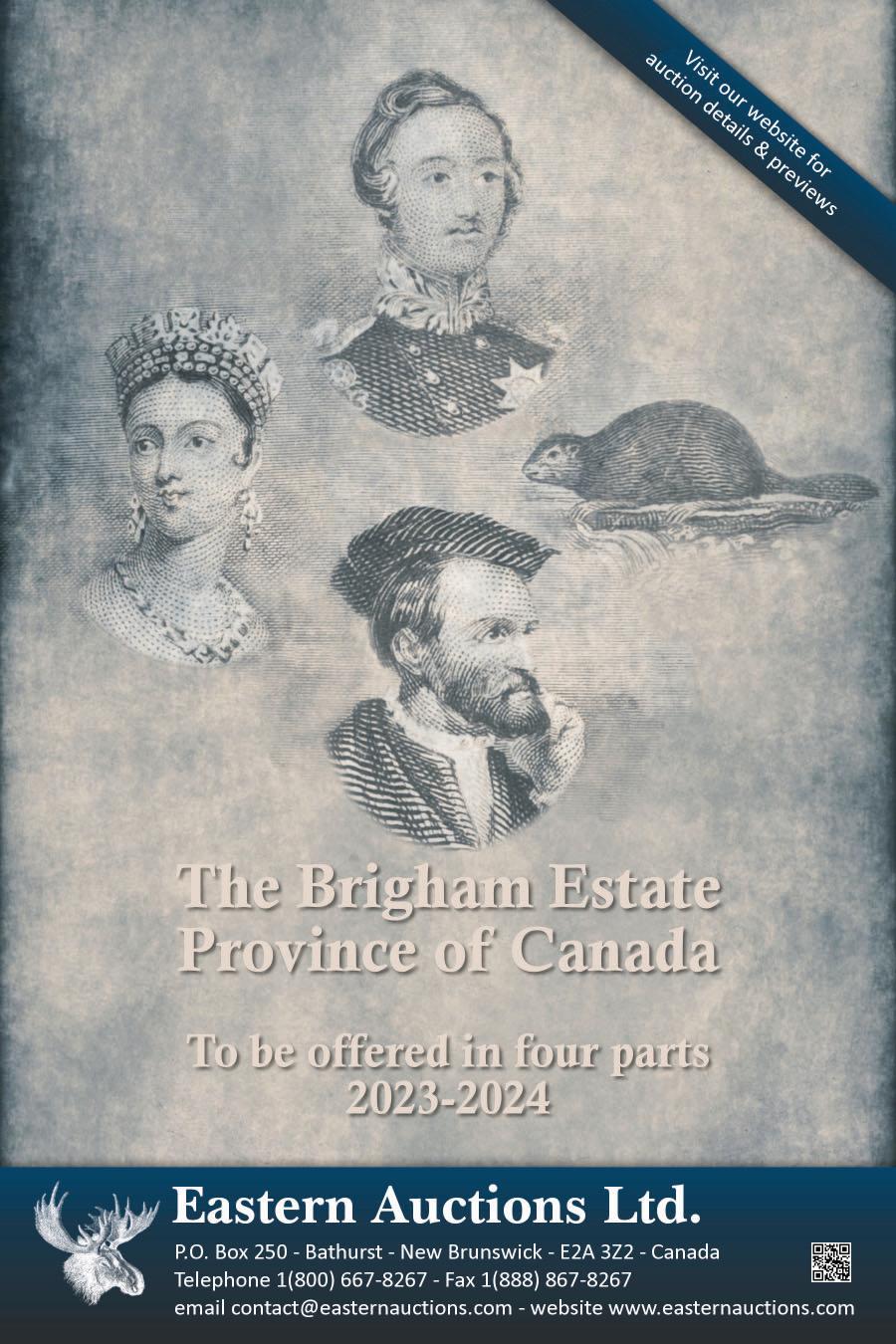
Mexico First Issue 1856-64: Unlocking the Mystery of District Overprints
The Unique 572-Stamp Set Challenge
Omar J Rodriguez, FRPSLIn this feature, the author describes the unique district overprint Mexican postal system created in 1856. He provides key data about district rarity and how many stamps are needed for a complete set. He believes judges need to include district rarity and district overprint completion level when assessing classic Mexico exhibits and comparing them with exhibits from other countries. He is a member of RPSL, APS, Club de Monte Carlo, Collectors Club of NY and MEPSI (Mexico-Elmhurst Philatelic Society, International).
Consider the five stamps shown in Figure 1. They are nice-looking examples of the 2r Emerald Green stamp from the 1856 first issue of Mexico (Scott 3b). They are all from the first plate of 60 stamps, which had larger margins between stamps than later plates. They would make worthy additions to any collection. Here is the surprising thing: although they are basically the same stamp, a likely auction price for each will be wildly different. The Scott 2021 catalog values this stamp at $55 for a used example of most of the 276, 940 issued from that plate; however, the first of these stamps (far left) will probably fetch $40, according to Nicholas Follansbee’s 2015 catalog (NF)1; the second will sell for $200; the third for $1,000; the fourth for $2,500. The fifth is worth likely $10,000. The value of this last one at the far right (Baja California) is based on its last sale 20 years ago. Since no other like it has been offered in the market since, its value today could probably be much higher. Why this disparity?
The reason is not condition, margins, cancellation or errors. The reason is the small overprint (in most cases vertical), which indicates the postal district from which these stamps originated. The 60+ Mexican postal districts were of very different sizes, so the need for stamps in each varied greatly. Examples from

the smaller postal districts are very hard to find. The price differential makes a lot of sense if you consider how many stamps were overprinted and may have survived from each of those districts:
Why are collectors willing to pay such large price differentials?
The dream of most classic Mexico collectors is to complete the whole set – to have at least one stamp of every denomination and from every district. This is ambitious because: 1) there were 13 different stamps – six in 1856 and seven in 1861; 2) there were 60+ districts and; 3) owning stamps from the smaller districts makes any collection better and more prestigious, so competition is fierce and the prices are high.
Obviously, district overprints create discovery opportunities for those who understand them and can detect forgeries. A sophisticated collector can find opportunities and obtain great finds from time to time.
Why were stamps overprinted?
The postal authorities were very concerned about the safety of the stamps sent out from the central printing office in Mexico City to the 60+ postal districts. The country was on the verge of a civil war and banditos attacked shipments on the roads, causing havoc. As a consequence, a unique postal system was created to protect stamp income: Stamps were not valid for postage until they had safely arrived in the postal districts and a local overprint with the name of that district had been applied by hand to each individual stamp. This is a unique security feature among classic stamps of the world. This system remained in place for all regular issues until 1884.
Why were postal districts so different in size? Which districts are more difficult to find?
Table 1 describes the four reasons for differences in district size: 1.) large population centers (such as Mexico City, Puebla, Guadalajara, San Luis Potosi or Veracruz) became the head office of their districts and received the lion’s share of the issue. Most of these stamps are common, with a few notable exceptions; 2.) areas with smaller population, but significant industrial, manufactur-
Large Population
•LargeCities
•LargePorts
Intense Commercial & Manufacturing Activity
•Ports
•Cities
•MiningCenters
•AgriculturalCenters
Geographically Remote
•NorthWest
•SouthEast RainForests
Small Population
-SmallTownsnear/at
Haciendasownedby influentialfamilies
-AllDirectShipments
IssuedStamps
DistrictRarity½R1R,2R4R8r
Rare<1,000<1,000<1,000<1,000
Scarce1,000-7,5001,000-10,0001,000-2,0001,000-1,500
Common>7,500>10,000>2,000>1,500
ing, agricultural or mining activity needed their own postal district because they produced a lot of business correspondence (e.g. Pachuca, Monterrey or Chihuahua); 3.) scarcely populated areas were required to be part of the mail network, although they produced little mail. The largest towns of those districts became the head offices (Baja, California;, Hermosillo or Victoria). Obviously, they received considerably fewer stamps; and 4.) politically influential men lobbied so that a district was created in or near their haciendas, although those towns had little population and did not merit being postal districts (such as Soyaniquilpam).
The criterion to classify districts as common, scarce or rare is explained at the bottom of Table 1. It is important to note that there are rare stamps even in the Common or Scarce districts, too. This is because some denominations were not always sent to all districts according to their size. This happened mainly with the 1861 4r in red ink (Scott 10) and 8r in green ink (Scott 12).
All the direct shipments (explained following) are in the “rare” category.
The complete list of districts and the scarcity of their stamps can be found in Table 2. It is organized by geographic area.
What are Direct Shipments?
The term direct shipment is used for shipments to a small group of towns that were not districts, but occasionally received stamps directly from Mexico City: 1) because of an emergency request when its district head office had run out of stamps (such as Colima, San Martín Texmelucan or Polotitlán) or; 2) because they were tiny towns under the authority of Mexico City (such as Cuautitlán, Tepeji del Río or Texcoco).
Postal Districts 1856-1864 By Economic Region
Unoverprinted
Pacific
Coast Atlantic Coast & SE North El Bajío (Low Lands) México City & Vicinity
Remote NW
Baja California
1856
Hermosillo Ports
• Mazatlán
• Acapulco
Small Towns
• Yguala
• Colima
1861
• Ciudad
Bravos
1856
• Tixtla Guerrero
Large Ports
• Tampico
• Veracruz
Small Ports
• Campeche
• Isla del Carmen
Gulf Inland Cities
• Huejutla
• Jalapa
• Córdoba
• Orizaba
• Mérida
Remote Rain Forests
• Tabasco
• Chiapas
Mining Centers
• Durango
• Zacatecas Cities
• Saltillo
• Chihuahua
• Monterrey
• Victoria
Large Cities
• San Luis Potosí
Guadalajara
• Guanajuato
• Querétaro
AgroCenters
Lagos
Aguascalientes 1861
All stamps from direct shipments are rare. Most do not bear any overprint, since they were not districts, or they have a Mexico overprint, but are canceled in these towns. Collectors consider them as additional “districts.” Figure 2 shows a pair from Polotitlán. This town belonged most of the time to the Querétaro district. Notice that this direct
Large Cities
• México City
AgroCenters
• Toluca
Mining Centers
• Pachuca
• Sultepec1856
•Temascaltepec 1856
Tlalpujahua
Small Towns
• Apam
• Chalco
• Cuernavaca
• Ixtlahuaca
• Lerma
• Soyaniquilpan
• Tula
• Tulancingo
South
Large Cities
• Morelia
• Oaxaca
• Puebla
AgroCenters
• Maravatío
Direct Shipments
Emergency Shipments
• Aguascalientes
1856
• Colima 1856
• Huatusco1861
• Polotitlán
• San Felipe del Obraje1856
• San Martín
Texmelucan
1861
• Tuxpan1861
• Villa del Valle
1856
Zitácuaro1856
México Subs
• Cuautitlán
Guadalupe Hgo
1856
• Tacubaya
• Tepeji del Río
• Texcoco
Tlalpam
shipment pair has no overprint and the date matches the time of that direct shipment. NF catalog values these stamps at $2,500 (as singles)1 .
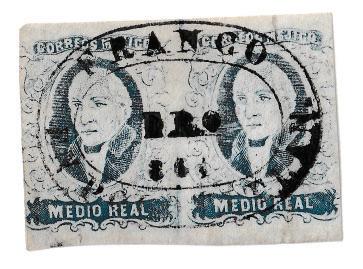
Occasionally, a few stamps missed the overprint by mistake. Those are not direct shipments and have only modest premiums over the regularly overprinted stamps. Only the direct shipments documented in the old post office records that Samuel Chapman found and published in 1926 count as such.
Has any other country had a similar system of district overprints?
No. This is a unique feature of classic Mexico 1856-83. As such, it should be considered an important element of rarity in exhibit competitions of Mexico classics, especially when comparing Mexico exhibits vs. classic exhibits of other countries.
How many stamps are needed to complete a set of the first issue?
The answer is 572 stamps: 293 from 1856 and 279 from 1861. Although original records show the stamps sent to each district, there was not a survey of survival of the rare ones until my survey in 2021. The 13 different types of stamps are as follows:
1856: The first issue was printed on white paper. There are six different stamps (five denominations in different ink colors and white paper, plus the additional 2r with narrow margins in different shades of green).

1861: Seven new stamps were released using the same plates, but on colored paper and black ink (same five denominations but 4r and 8r values were printed in two different ink colors). These two ink colors were printed in parallel during most of the issue but the new color was initially sent only to a handful of districts. Later on, half the other districts received a few of those stamps in new colors. Those are rarities.
Not all the districts received all 13 denominations. And not all the issued stamps have survived, as many were issued in small numbers. My 2021 survey published in MEPSI’s Mexicana2 showed that 80 of them probably have not survived.
So, a collector would need 572 different stamps to own a complete set of the First Issue of Mexico. Undoubtedly, it is the largest classic set among first classic issues in the world. The complete list of districts is shown in Table 3 at the end of this article.
Has anyone ever owned a complete set?
No. No one has ever owned a complete set.
And, it is unlikely that anyone ever will.
This is because a significant number of those stamps are unique (or almost unique) and the pool of specialized collectors is large enough to make competition for them very difficult. An example of the market dynamics is shown by the high price of the likely unique Baja California 2r Emerald shown at the beginning of this article.
At present, the most complete known collections by district have 90-95% of the set. Yet some of the missing stamps in those collections are spread out in the hands of several other collectors, who would hardly let those rarities go at any price.
Therefore, judges of Mexican classic exhibits should never expect to fi nd 100% complete district collections. However, a high percent of completion, or the presence of key rare districts in an exhibit should be rewarded and taken into account when comparing with exhibits of other countries.
How do we know how many stamps were sent to each district and how many have survived?
A total of 652 different stamps were originally issued, but only 572 have survived: Stamps sent to Districts: Detailed records of 1856-64 shipments to each district were found by Samuel Chapman and published in 1926. Those records did not contain the breakdown of the 1861 4r and 8r in two different colors. Table 3 contains issued stamps by district and direct shipments, including the likely breakdown of the 4r and 8r into two different colors. The gray cells show some 1861 stamps that previous researchers thought were issued (4r red and 8r green), but in fact never were. Those should be reclassified as issued in the regular 4r and 8r colors.
Surviving stamps: My survey of surviving rare and scarce district stamps is shown in the white cells with numbers of issued stamps in Table 3. At least one genuine stamp in those cells was reported to be in collections or in past auction catalogs. The cells shown in yellow are stamps issued, but not reported, and probably did not survive. This survey was completed and published in MEPSI’s Mexicana in 2021 and was updated with a couple of new finds in 2022. That survey found that 80 of those 652 stamps have not survived. So, only 572 different stamps are needed to complete the set.

Hidalgos 1856 and 1861
Survey of Reported Stamps Updated 2022 (1/2)
Shipments by District (1)
1 Source: CelisCano’s SellosPostalesde Mexico , #3 First Plates from Mark Banchik’s Handbook of Classic Mexico . #9-12 from Roberto Liera’s Mexicana article The High Values of 1861 Issue + Jalapa, Maravatío#10 and Campeche #12 (MEPSI cert).Aguascalientes 1861, from Samuel Chapman The Postage Stamps of Mexico 1856-1868. Catalogue numbers are from Scott Catalogue
2 Direct shipments, only without overprint
3 Subdistricts of Mexico (Guadalupe Hidalgo, Tacubaya, Tepeji, Texcoco and Tlapam) with or without Mexico overprint.Huatusco#8 is known with Mexico overprint.
4 In 1856 without district overprint only (direct shipment).In 1861 with district overprint.
Hidalgos 1856 and 1861
Survey of Reported Stamps Updated 2022 (2/2)
Shipments by District (1)
1 Source: CelisCano’s SellosPostalesde Mexico , #3 First Plates from Mark Banchik’s Handbook of Classic Mexico . #9-12 from Roberto Liera’s Mexicana article The High Values of 1861 Issue + Jalapa, Maravatío#10 and Campeche #12 (MEPSI cert).Aguascalientes 1861, from Samuel Chapman The Postage Stamps of Mexico 1856-1868. Catalogue numbers are from Scott Catalogue
2 Direct shipments, only without overprint
3 Subdistricts of Mexico (Guadalupe Hidalgo, Tacubaya, Tepeji, Texcoco and Tlapam) with or without Mexico overprint.Huatusco#8 is known with Mexico overprint.
Are there stamps with forged district overprints? Should you be worried about them?
Yes, there are. Credible forgeries started to appear in the 1890s, which were created by forgers using parts of stolen original plates. This should not stop you from collecting these stamps. There is plenty of information about them and a new book with all known details is in the works, so you can learn to detect them. For high value purchases, you should buy stamps on extension and send them to the MEPSI Expert Committee. Its opinions are very inexpensive. How do philatelic judges reward exhibits with rare districts?
The short answer is, for the most part, they don’t.
The reasons are twofold:
1. Very few judges are familiarized with the system of district overprints. Consequently, judges focus on traditional criteria and reward traditional treatment of exhibits by denomination, not by district. The rarity or district completeness is almost never factored in.
2. Exhibitors tend to follow the traditional exhibit treatment to make sure judges look at theirs the same way they look at exhibits of any other country. Four Mexico First Issue exhibits have won the Champion of Champions in the United States so far and all were organized this way.
Since rarity in Mexico classics is based on the unique system of district overprints, the exhibit treatment for this country needs to include grouping the material by postal districts, not just by stamp denominations. Only then will the judges be able to evaluate the completeness of the exhibit and its district rarities.
More information about Mexico Classic issues is in Nicholas Follansbee’s 2015
A Catalogue of the Stamps of Mexico 1856-1900 (for copies, contact NF at PO Box 3210, Ashland OR 97520-3210).
Although the last edition has not been updated, it still contains much data that is current. The market prices by district have not changed much and keep a similar relationship to each other. Marc Gonzales, the MEPSI past president and head of the expertizing committee, has a new book in the works which will make detecting district overprint forgeries of this issue much easier.
For more information about this upcoming book, the MEPSI Expert Committee or about joining MEPSI, contact Marc Gonzales at MARC3771@aol.com or PO Box 29040, Denver CO 80229-0040.
I want to thank my colleagues, especially Marc Gonzales, who read this article and provided me with feedback.
Endnotes
1. Follansbee, Nicholas. A Catalogue of the Stamps of Mexico 1856-1910, published in 2015.
2. Rodriguez, Omar. “How Complete is your 1856-1861 Collec on? A 2021 Survey of Elusive Stamps,” Mexicana Vol. 70, Number 3, July 2021, pp. 126-129.
Nobody does it better.

Heritage—Over 75 years of experience in expertizing stamps and covers from the greatest collections ever formed.
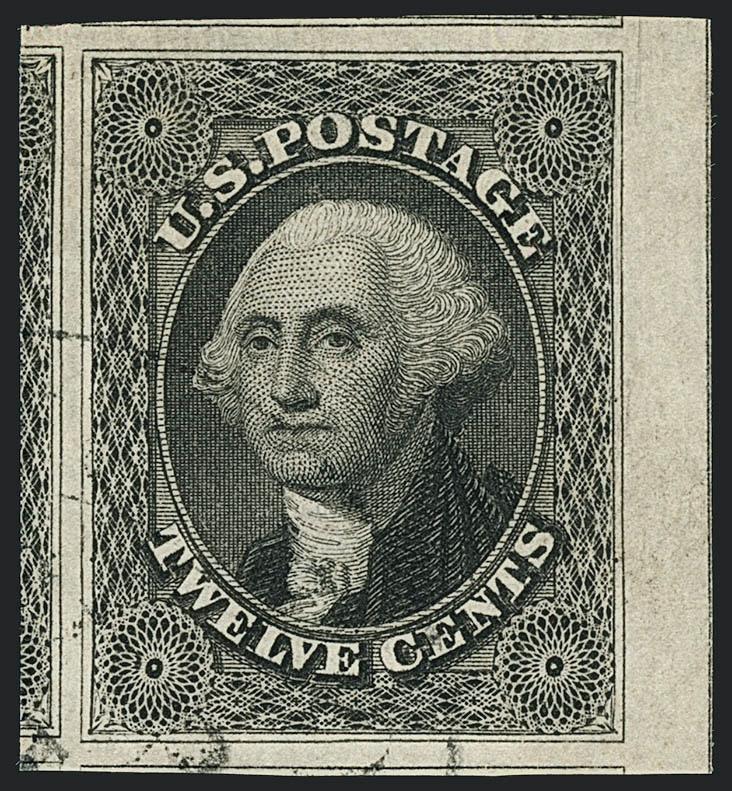
Expertise—An outstanding staff of in-house experts and consultants with lifetimes of experience backed by a 250-volume reference collection and the latest in high technology equipment.
Authority—Recognition as a leader that comes from a time-honored history of knowledge and expertise.
Certificates—With over 590,000 certificates issued to date, a PF Certificate is recognized as the most authoritative and reliable opinion in all of U.S. philately. Add value to your collection with a PF Certificate.


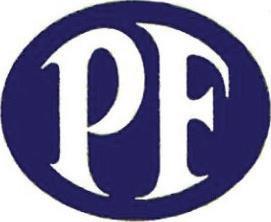
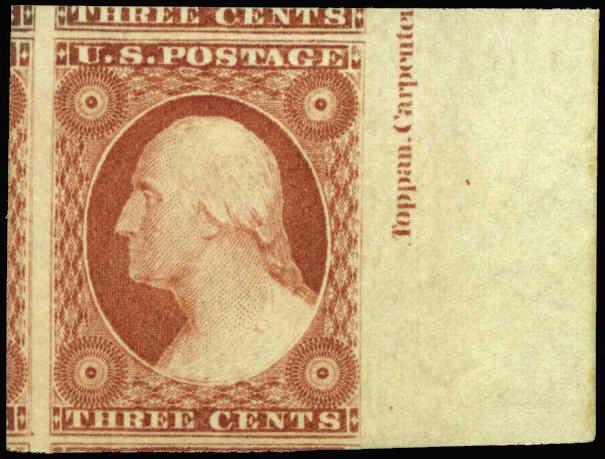

353 Lexington Avenue, Suite 804 New York, NY 10016 tel. 212-221-6555
PhilatelicFoundation.org PFsearch.org
 Scott 11 graded 100-J. PF Certificate 521651
Scott 233 graded 98-J. PF Certificate 431008
Scott 17 graded 100-J. PF Certificate 535539
Scott 11 graded 100-J. PF Certificate 521651
Scott 233 graded 98-J. PF Certificate 431008
Scott 17 graded 100-J. PF Certificate 535539
298–307 CORINPHILA A 2–3 & 5–9 JUNE 2023
British West Africa –
The ‘BESANÇON’ Collection (part II)
Australian States & Commonwealth of Australia –


The ‘DUBOIS’ Collection (part II)
Ecuador 1865–1872 –
The ‘GUAYAQUIL’ Collection (part III)
Great Britain: Line Engraved Issues 1840–1870 –
The Åke Rietz Collection

Great Britain: Mint Victorian Stamps & St. Lucia: Mint First Issues
– The ‘CHATEAU DU SOUDUN’ Collection


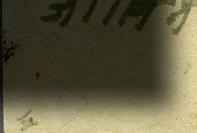


Austria & Lombardy-Venetia 1850–1867 –
The ‘WALDVIERTEL’ Collection (part II)
Italy, France, European Countries and South America –
The Ing. Pietro Provera Collections (part VI)
Zeppelin – The ERIVAN Collection (part II)
Switzerland, incl. Ziffermuster 1882–1899 –

The Dr. James Johnstone Collection
All World – Stamps & Postal History, incl. Austria – First Stamp Issue 1850 The ‘HABSBURG’ Collection (part II), Newspaper Stamps of Austria and Lombardo-Veneto The Anton Theodor Gaube Collection, Cyprus – Austrian Post Office The ‘DUBOIS’ Collection (part II), Hungarian Post Offices in Romania The Dr. Geza Homonnay Collection, Greenland
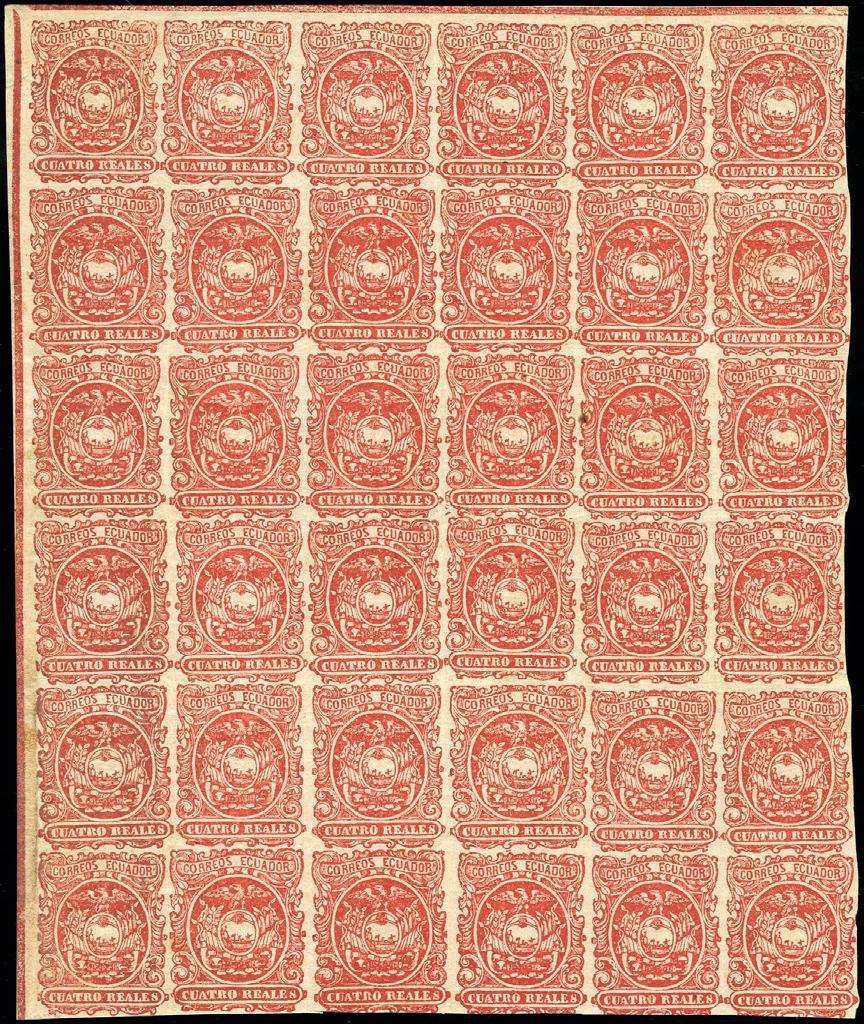

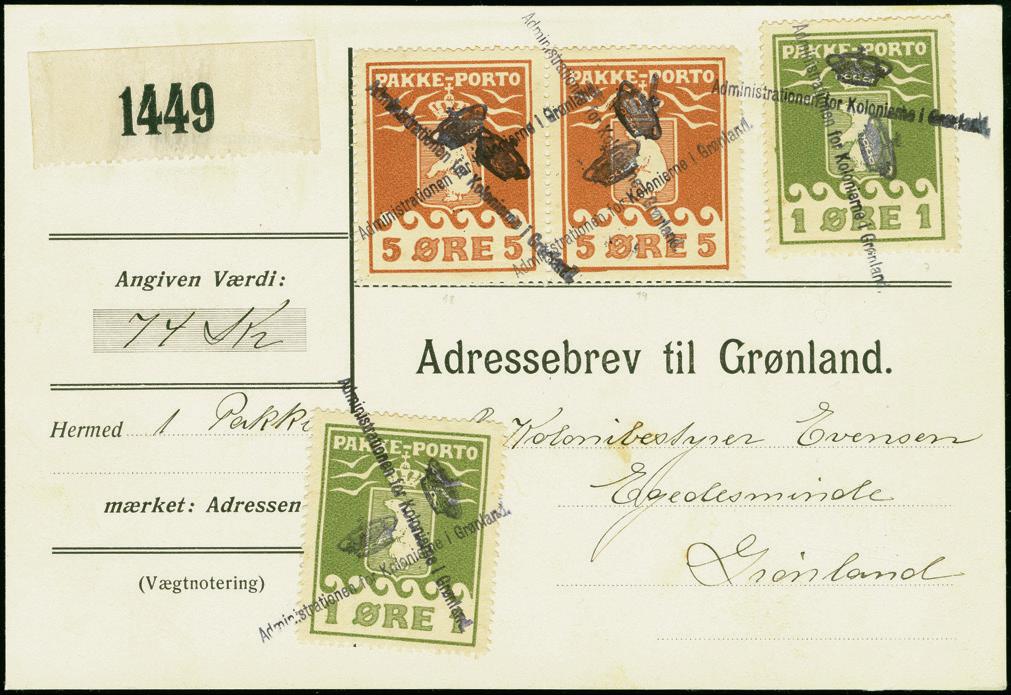
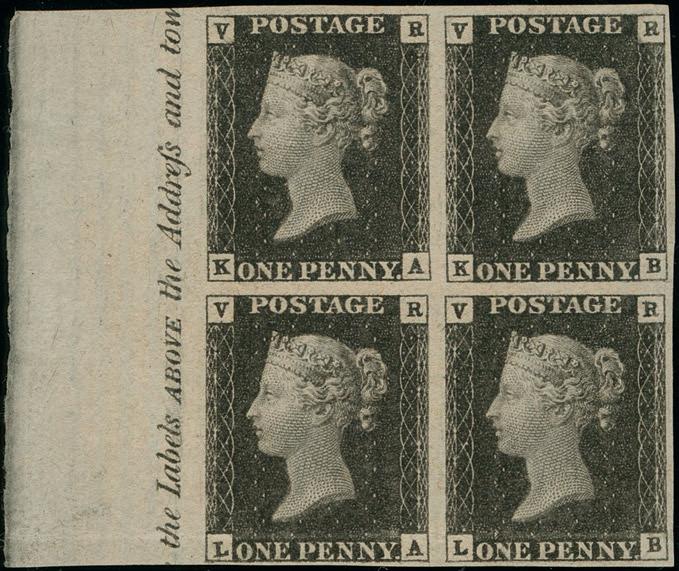
1721–1938 The ‘POLAR LIGHT’ Collection (part I), Australian States – Unused The Peter Campbell Collections (part I), Australia – King George V The Steve Butcher Collection, Postal History of Nepal The Robert Wightman Collection, Principality of Liechtenstein 1912–1940 The Hansruedi Keller Collection



 Never issued! Provenance: Dublin Find (1899) Earl of Crawford (1911) Edward Granger (1960s)
Never issued! Provenance: Dublin Find (1899) Earl of Crawford (1911) Edward Granger (1960s)
AUCTION


Never Issued: Intended to replace the ‘Kangaroo and Map’ stamps in 1914!




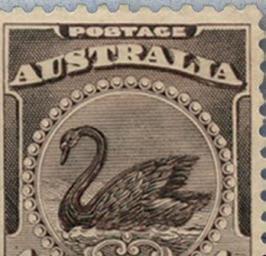



Provenance:
Agar Wynne (after 1934)
Franklin Burchett (approx. 1940)
Jack Cato (1954)
Herbert McNess (1979)
Arthur Gray (2015)
Postage for a complete set of 10 catalogues
CHF 20.– EUR 20.– US $ 30.- GB £ 20.(including 9 hard bound auction catalogues)

ORDER AUCTION CATALOGUES NOW OR VISIT WWW.CORINPHILA.CH
Internet Auction Catalogues online



Online live bidding: registration online








SPECIAL VIEWING
All single lots from the upcoming auction will be available for viewing at IBRA 2023 in Essen, Germany.

Cancellation Ink Analysis
Understanding the inherent limits of scientific instrument features in use when submitting a canceled stamp or cover cancellation for philatelic expert certificates
Mel Kravitz RPSL Jeffrey S. Schneider FRPSLIntroduction
Canceled stamps and handstamped covers with post office markings submitted to philatelic expert committees for certificates of authenticity will be routinely examined using comparative test characteristics to known good criteria. These will include a search of provenance, auction record and previous certificates. Further, unlike 10-15 years ago, there frequently is the application of scientific instrument testing, which may include a review using a document digital imaging instrument such as the VSC80001. For stamps, this instrument is capable of providing results on repairs, bends, creases and reperforations through the instrument’s superb magnification, infrared and overlay technology, which may also be applied to cancellation inks or dyes. There is a non-destructive spectral analysis feature for documents that can identify differences in ink and paper formulations. However, this spectral analysis feature is an issue when testing cancellation inks and dyes, an issue often overlooked by the examiner. The post offices changed inks and dyes abruptly, and clerks routinely combined inks and dyes, creating mixtures. They even occasionally used pen ink to cancel stamps or for handstamps (Postmasters were directed to do this in the United States,2 when black printers’ ink was unavailable to cancel stamps).
The VSC8000 reflective spectral graph is only capable of revealing whether the cancellation ink or dye is different in consistency of color or cancellation colorant to that of a comparison “known good.” To have any meaning, a comparison to a recognized authentic cancellation on cover must be made. The VSC8000 does not give any information on the chemical compound.
Supplementing the VSC8000 instrument, such committees may have access to XRF instruments to provide ink or dye chemical element content; however, the current instruments are limited in detected elements, with the lighter elements not detected.3 The major drawback of this instrument is that the user must guess what compound the detected elements represent, as in the spectrum of Cinnabar, Mercury Sulfide or HgS on a cover handstamp. The XRF element spectrum here may contain many elements, only two of which are Mercury (Hg) and Sulfur (S).
The red compound HgS must be assumed by each element’s presence, a less than pleasing scientific approach in detecting the presence of Cinnabar.
Raman micro spectrometry can and has been used to characterize the inks and dyes used by post offices. It does not require a known good, since it is not a comparator, unlike the VSC8000 which utilizes the reflective spectral feature. It does not produce an element spectrum, as does XRF. What it does detect is the ink or dye by providing a Raman spectrum. This is accomplished by exposing the sample cancellation to a laser of choice, and the instrument software produces not a reflected line spectrum, but instead a connected series of molecular bond peaks associated with the chemical bond vibrations in the ink or dye molecules, while the bonds are absorbing a small amount of laser Raman light energy. These peaks are called Raman shift peaks. These resonance or stretching peaks are a definitive characteristic of all compounds and differ for each ink or dye compound. The results for the examiner are conclusive, but compound recognition is dependent upon matching to a saved library spectrum or prior published research data. The successful use of this instrument is contingent upon building a large consistent database for post offices in the time period of interest.
A comparison of the VSC8000 and Raman micro spectrometer4 instrument test results for separate covers with handstamp inks or dyes will illustrate.1
Cover No. 1


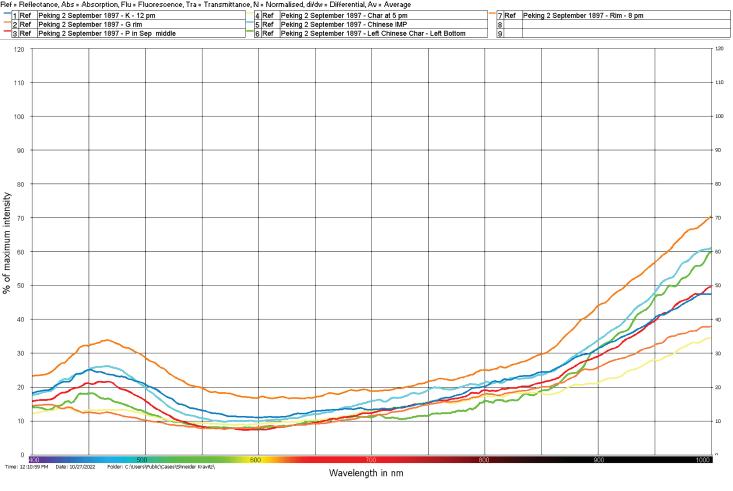
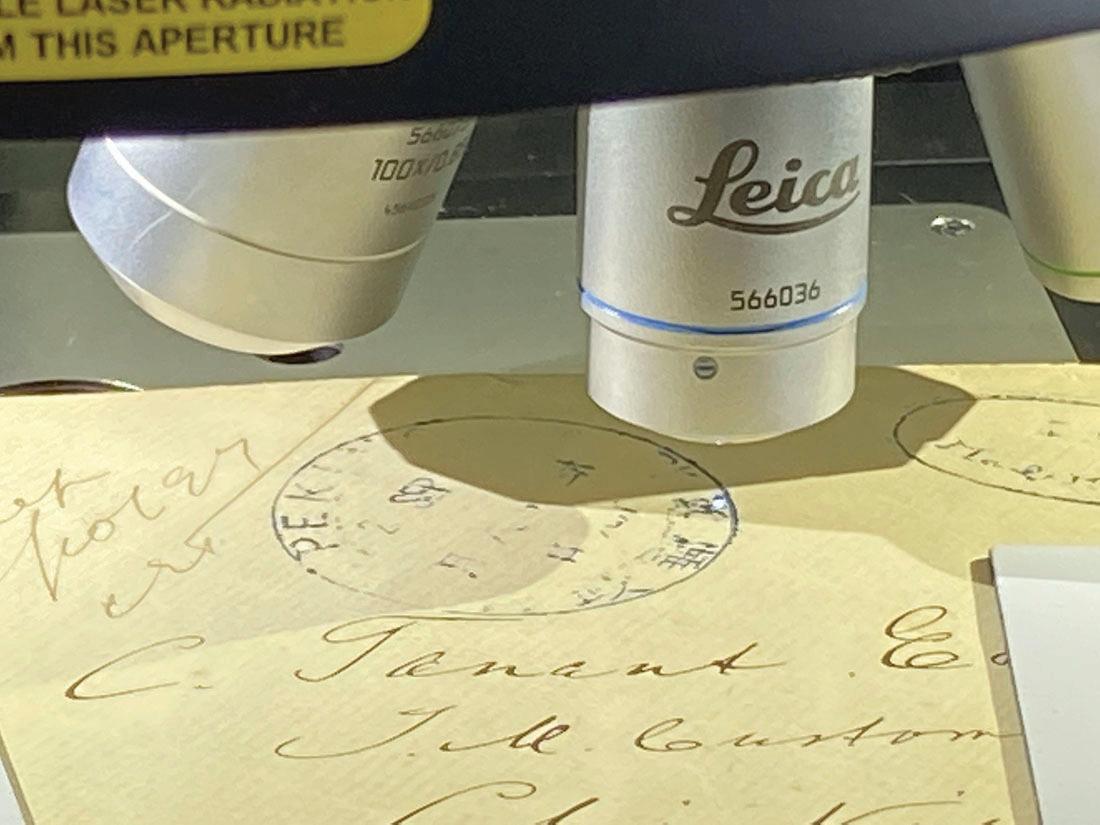
Raman micro spectrometer4 analysis of the Peking to Chinkiang Sept. 25, 1879, Peking dollar dater cancellation ink or dye.
Conclusion and comments
The ink used at Peking on Sept. 25, 1897 was a mixture of three inks, not a repair or tampered item. Similar inks were used at the Shanghai Imperial post office during this period. The obvious comparison to the VSC8000 data is that Raman describes what compounds were used. That this is not a single ink but an intentional mixture, possibly resulting in the VSC instrument raising an issue of
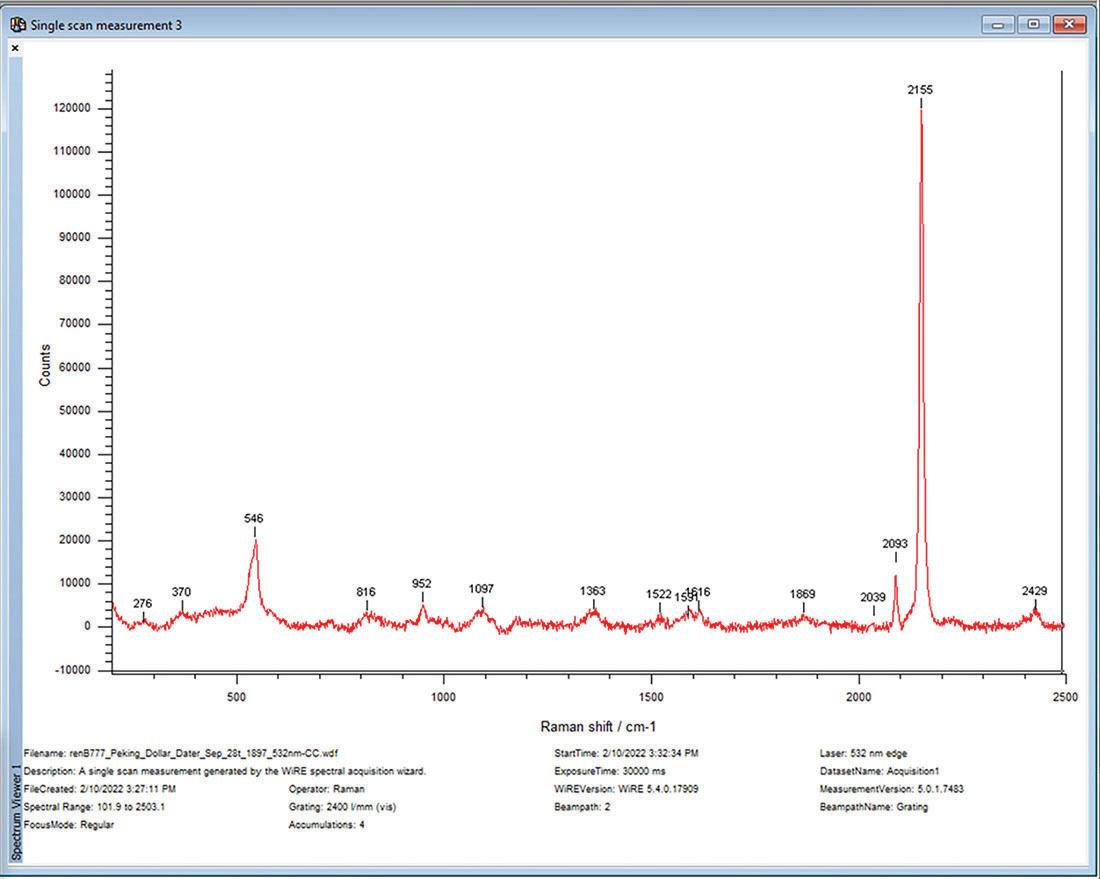
www.collectorsclub.com
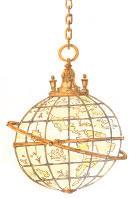
is no surprise that this saved Raman spectrum is used for comparison to the Peking Sept. 25, 1897, Raman spectrum. Prussian blue peaks are at 276, 370, 2053 and 2156, with the ultramarine peaks at 546, 816, 952, 1097, 1363, 1522, 1616, 1869 and 2429 Raman shift / cm-1. With a small amount of amorphous carbon black ink ‘D’ and ‘G’ peaks in the range of 1350-1600.3

authenticity. Cancellation ink in general is too complex for this VSC feature to provide useful information.
Cover No. 2
The Postal Laws and Regulations of the United States 1879, section 822, required that post office origin of registered mail be marked with “REGISTERED.” The town and date and color of the ink was not specified.


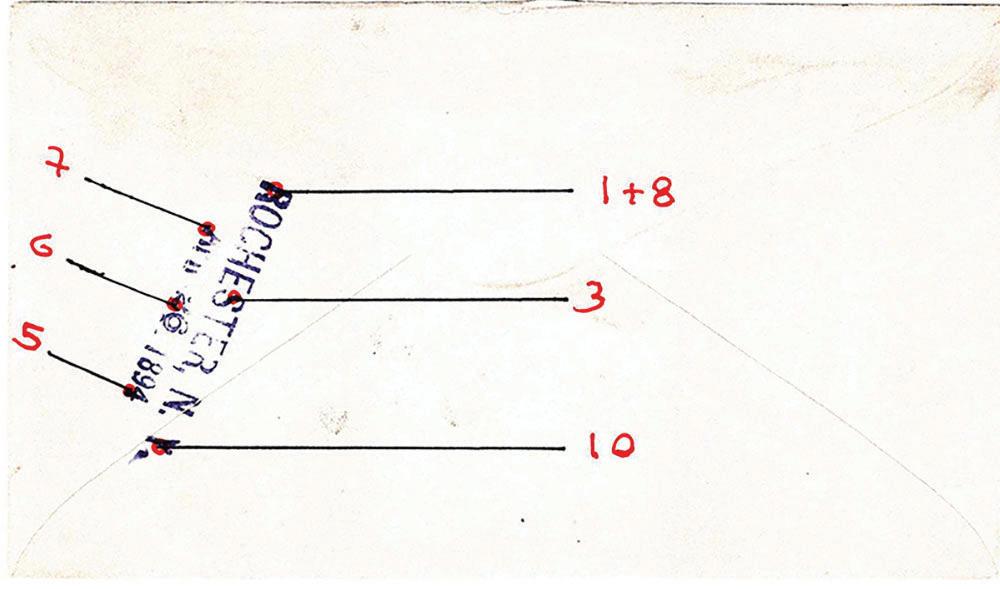

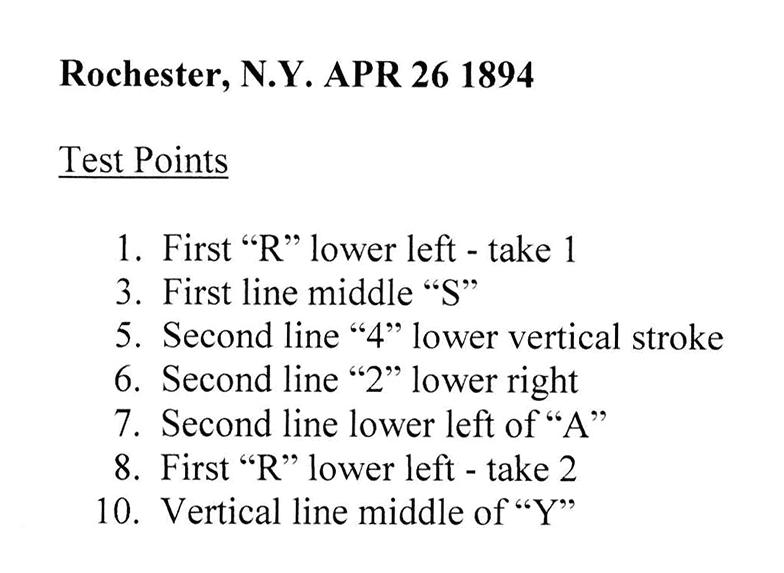






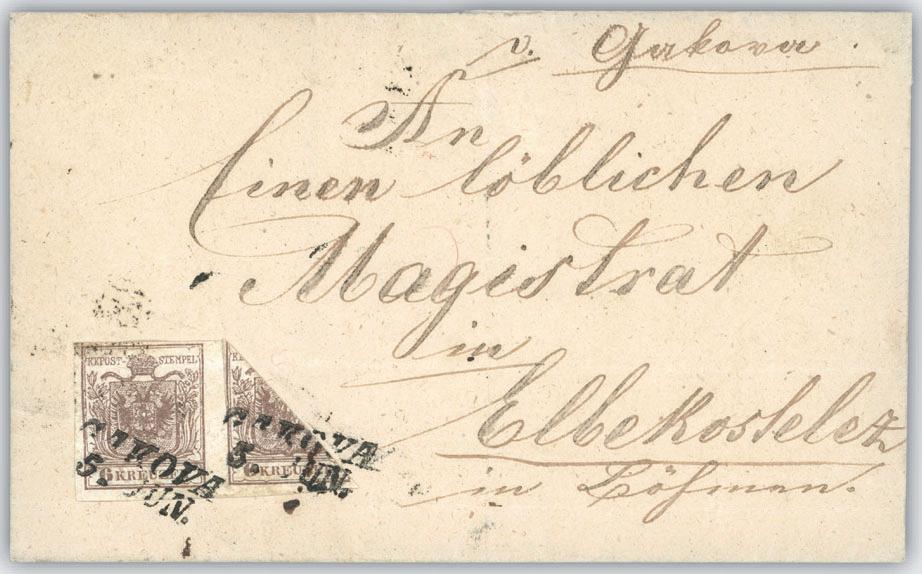

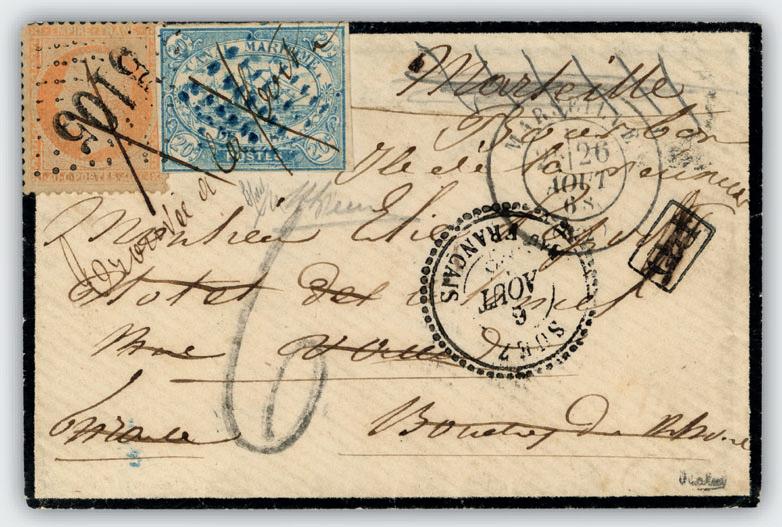




Violet , a pararosaniline dye, a synthetic created in Europe in the 1850s. The match to a saved Millipore Sigma commercial sample is 0.928 out of a perfect 1.0. Raman allows the creation of libraries to match unknowns against. This is a uniform compound free of additives, not a mixture. This identification is positive, it has the chemical formula C25N3H30Cl.5.
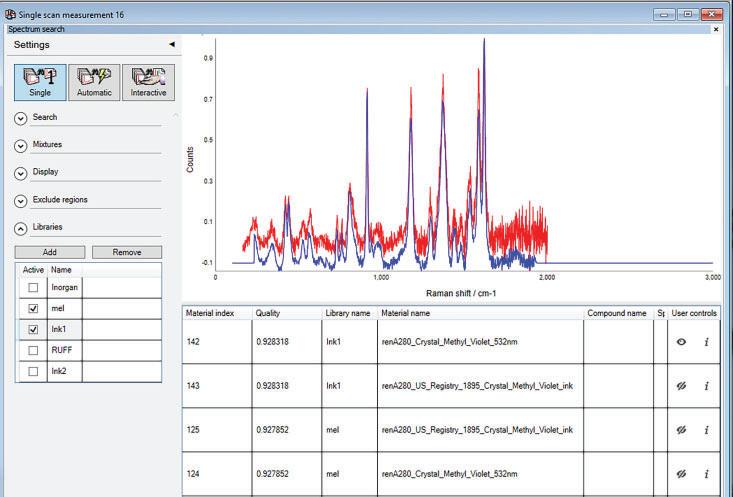
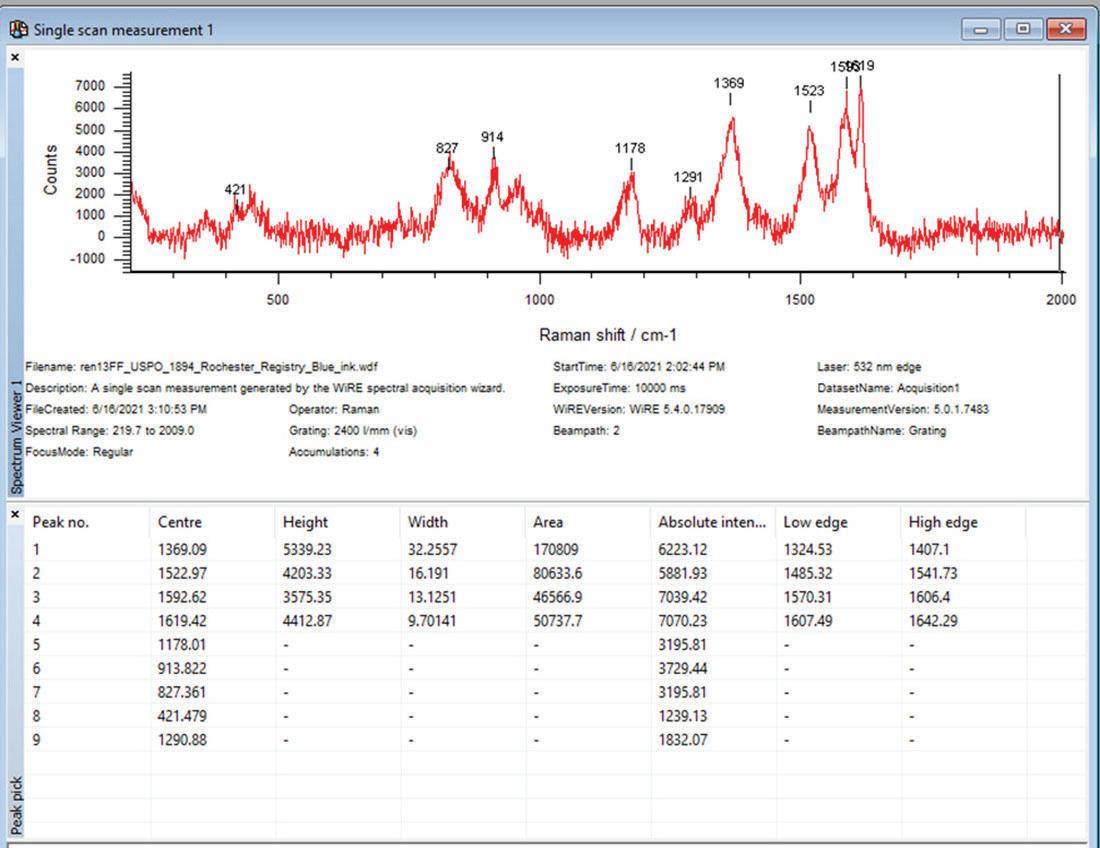
Raman micro spectrometer analysis6 of the Rochester, N.Y., April 26, 1894, blue ink or dye datestamp.
Cover No. 3
Registered cover from St. Louis, Mo., April 9, 1895, to Topeka, Kans., arriving April 11, 1895. The Topeka arrival violet ink or dye will be tested using the VSC8000.6

Raman micro spectrometer analysis of the Topeka, Kans., April 11, 1895, violet registered cancellation ink or dye.
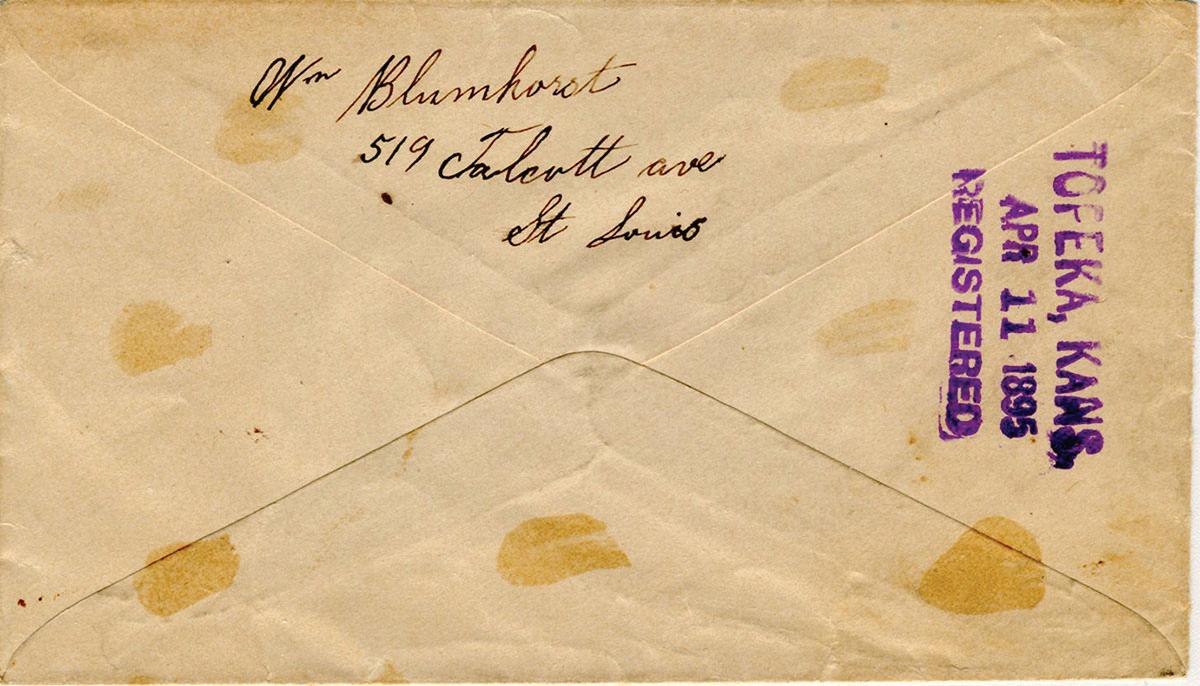











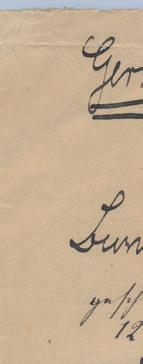
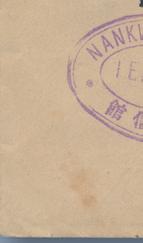








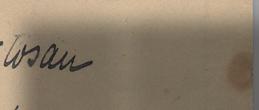
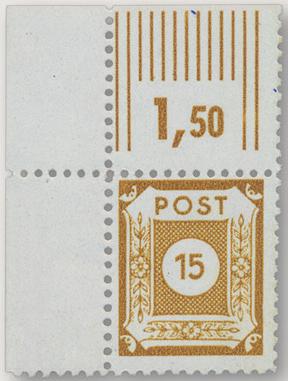
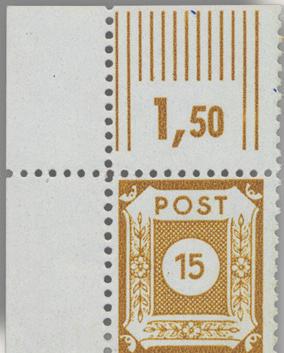





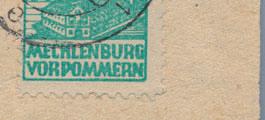






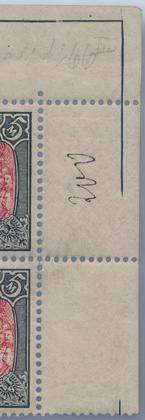




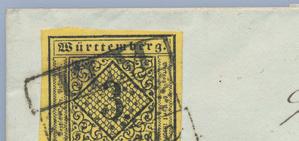


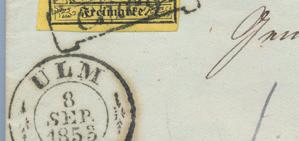


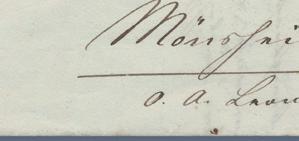
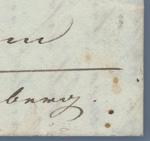

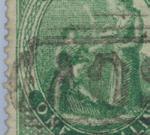
Conclusion and Comments


The comparative test results for the three postal history covers should clearly cast doubt on the use of the VSC8000 by any organization on cancel inks or dyes. All three of the postal history items are authentic. This feature is present in the VSC8000 to be used in testing the color spectrum of homogeneous printers ink on

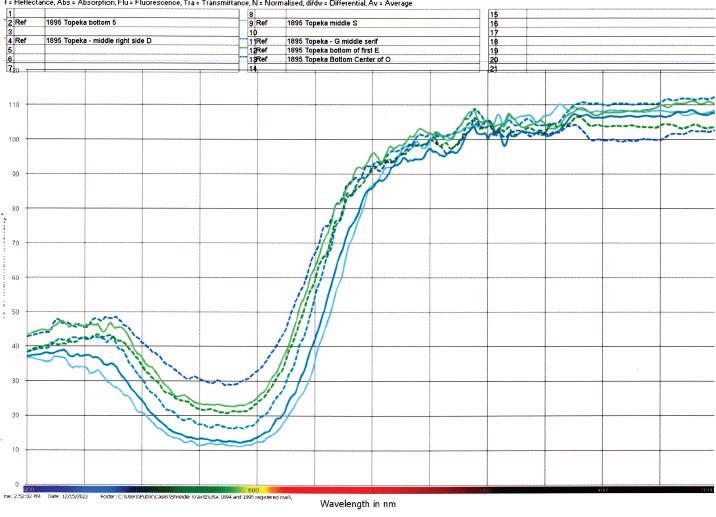

Crystal
Violet, a pararosaniline dye. It is a match to a saved Millipore Sigma commercial sample and is 1.0 out of a perfect 1.0. This is a uniform compound free of additives, not a mixture. This identification is positive, and it has the chemical formula C25N3H30Cl. So, Raman is color blind unlike the reflective graphical spectral feature of the VSC8000.7
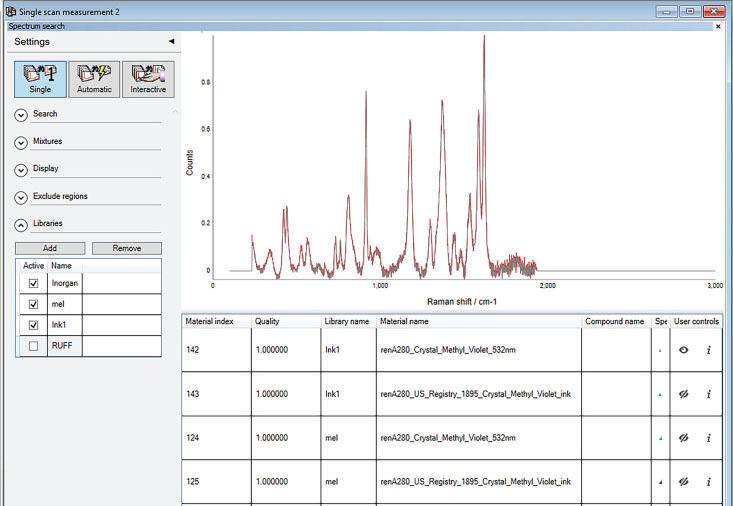

a large run of paper artifacts, such as currency bills or postage stamps. For stamp ink testing, it can yield color variations in a production run. These errors of color detection are an important feature of this instrument. It remains a powerful tool in the expertizing tool box.

Raman will yield the exact compound or mixture of compounds having been used by the subject post office on the cancel date. Raman can detect forgeries easily if the result is a compound invented after the date of the cancellation or handstamp. For expert committees using the VSC8000 when dealing with postal history ink cancellations, there exist many non-homogeneous “mixtures,” which cause a wide discrepancy of reflective spectrum responses or curves obtained, because the ink or dye at point A is not necessarily at point B. Mixtures were routinely created as clerks canceling stamps and covers ran low on ink or dye and added an old batch to a new supply. The Sept. 25, 1897, Peking dollar dater ink mixture is typical. Here, there are three different non-homogeneous inks mixed, and the VSC results show a wide difference in spectral responses at the selected test points on this one Peking cancellation.8
For the violet and blue colors of the 1894 and 1895 registered covers, we see that the VSC8000 reacts to the color differences (it is not color blind), as is shown in Figure 19. This clearly is a severe drawback in the use of this instrument’s reflective graphical feature on cancellation inks or dyes. For Crystal Methyl Vio-
let, the dye color can easily be manipulated by dye makers, yet Raman spectral analysis tells us these are same compound.
Raman also has limits. Ink or dye cancellations are thin film residues deposited by a cancellation device, and very light cancellations may not yield a Raman spectrum. SERS or Surface Enhanced Raman Spectrum technology using nano particle (Gold or Silver) solutions cannot be used to provide a Raman spectrum for weak residues, since this will smear a cancellation. Raman, in general, offers a powerful tool to be used for cancellation ink or dye analysis, but also requires building a library of known spectrums for successful use. Even with Raman, the operator can draw the wrong conclusion because of never having encountered a certain ink or dye.
XRF can supplement Raman when a new spectrum appears in highlighting which heavy elements, if any, are in the ink or dye, which can narrow down the search for a match to a selective category of colorants while discarding others. For red dyes 6, the appearance of Bromine with no Sulfur or Sodium rules out several Acid Red dyes, while pointing to Eosin B, chemical formula C20H8Br2N2O9. Another example may be in ruling in or out amorphous waste ivory or bone black ink. Carbon for amorphous carbon ink derived from ivory or bone will contain almost 50% calcium phosphate 7 residue as a result of heating bone to obtain carbon. XRF testing of an Ivory black cancel ink should then yield Phosphorous and Calcium in large quantities. If so, then we can eliminate lamp black, coal, charcoal (wood), and other sources of carbon.
25, 2023 including classic Switzerland and the ‘Martin’ Collection of airmails request your catalogue now

May 23

31, route de Troinex 1234 Geneva, Switzerland
info@letimbreclassique.com

Acknowledgements
Special thanks go to Dr. Susan Smith, Winton M. Blount Research Chair of the Smithsonian National Postal Museum, for the two separate days spent allowing Dr. Jeffrey Schneider to test the three postal history items, with the data published here, and her invaluable guidance in the use of the VSC8000.9
Endnotes.
1. VSC8000: https://fosterfreeman.com/vsc8000-hs/

2 Postal Laws and Regulations of the United States 1879, www.google.com/books/edition/The_ Postal_Laws_and_Regulations_of_the_U/aEz-7WqjDmAC?hl=en&gbpv=1&dq=ostal+Laws+an d+REGULATIONS+1875&pg=PA347&printsec=frontcover
3. Bruker Elio XRF: www.bruker.com/en/products-and-solutions/elemental-analyzers/micro-xrfspectrometers/elio.html
4. www.renishaw.com/en/invia-confocal-raman-microscope--6260
5.The Freedom, N.Y., postmaster did not adhere to the postal regulations, since “REGISTERED” is missing. He may have been both the postmaster and the store keeper in a small community. The postmaster general admonished this behavior in a postal notification in 1880, and warned of dismissal to those postmasters who would deviate from the regulations.
6. Mel Kravitz, San Francisco post office red ink and dye used for Registered and Special Delivery handstamps 1868 to 1938, Unpublished, 2023.
7. Bone Black: www.naturalpigments.com/pigments/pigments-by-color/black/bone-blackpigment.html 10
ProFi: Expertise in Seconds
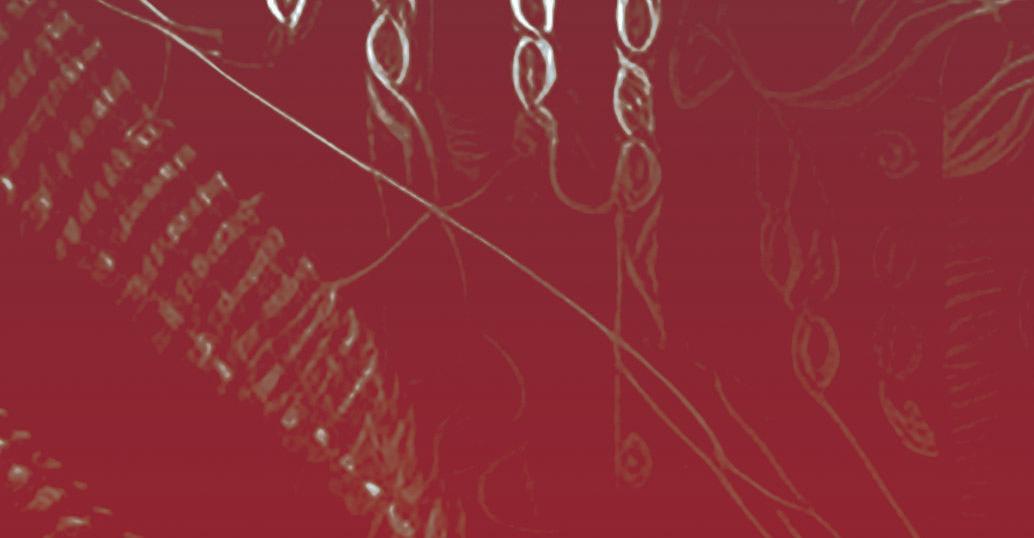

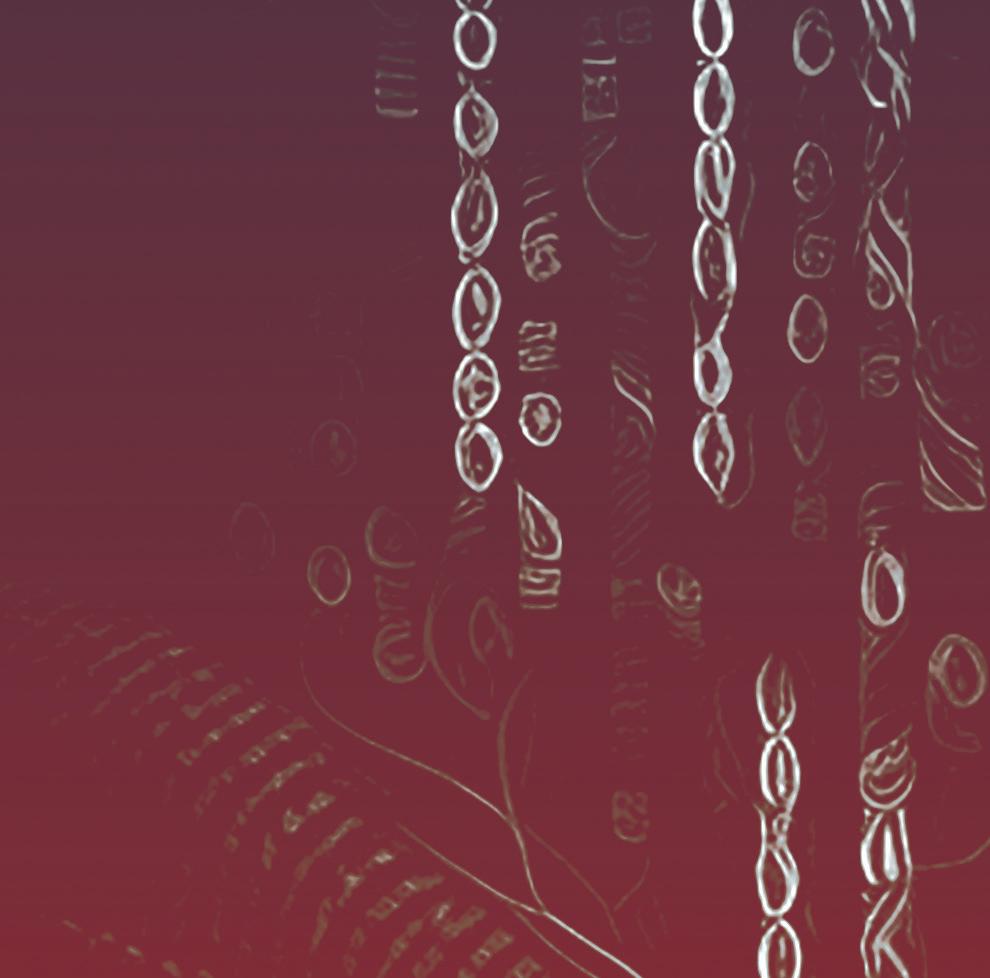

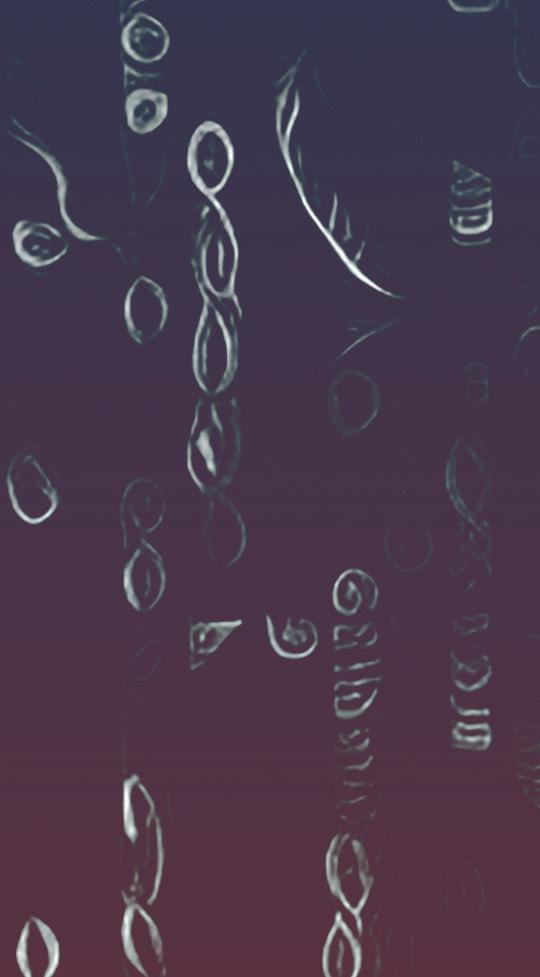




The start of a new philatelic era: Experience the ProvenanceFinder live at Heinrich Köhler during IBRA. All you have to do: bring along a rare item from your collection and take home the expertise on importance, value and provenance!



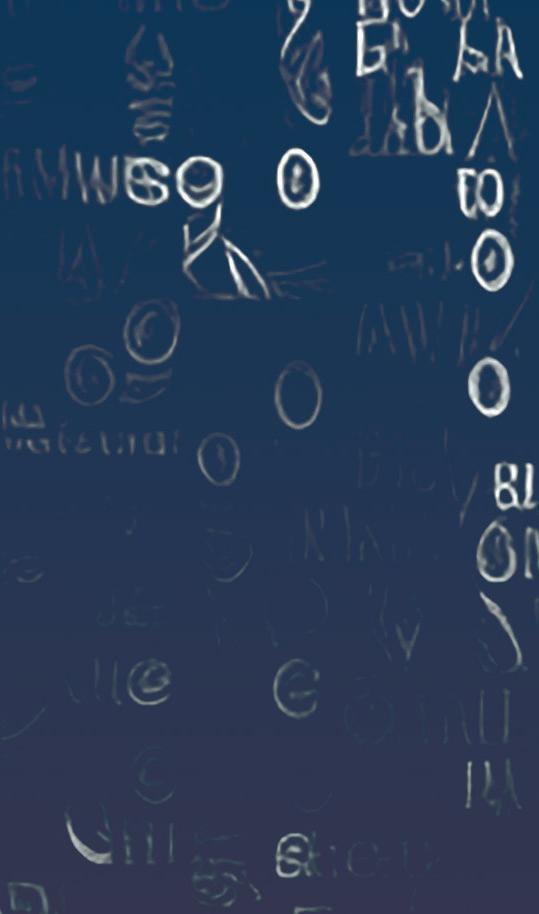

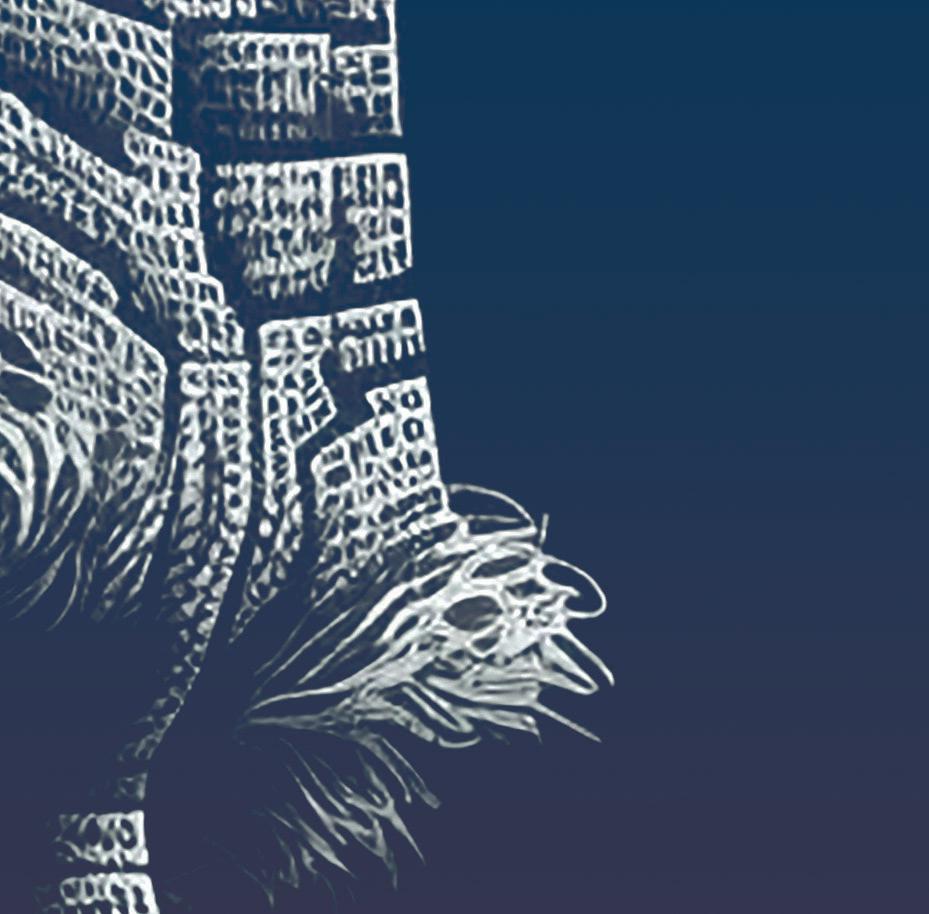

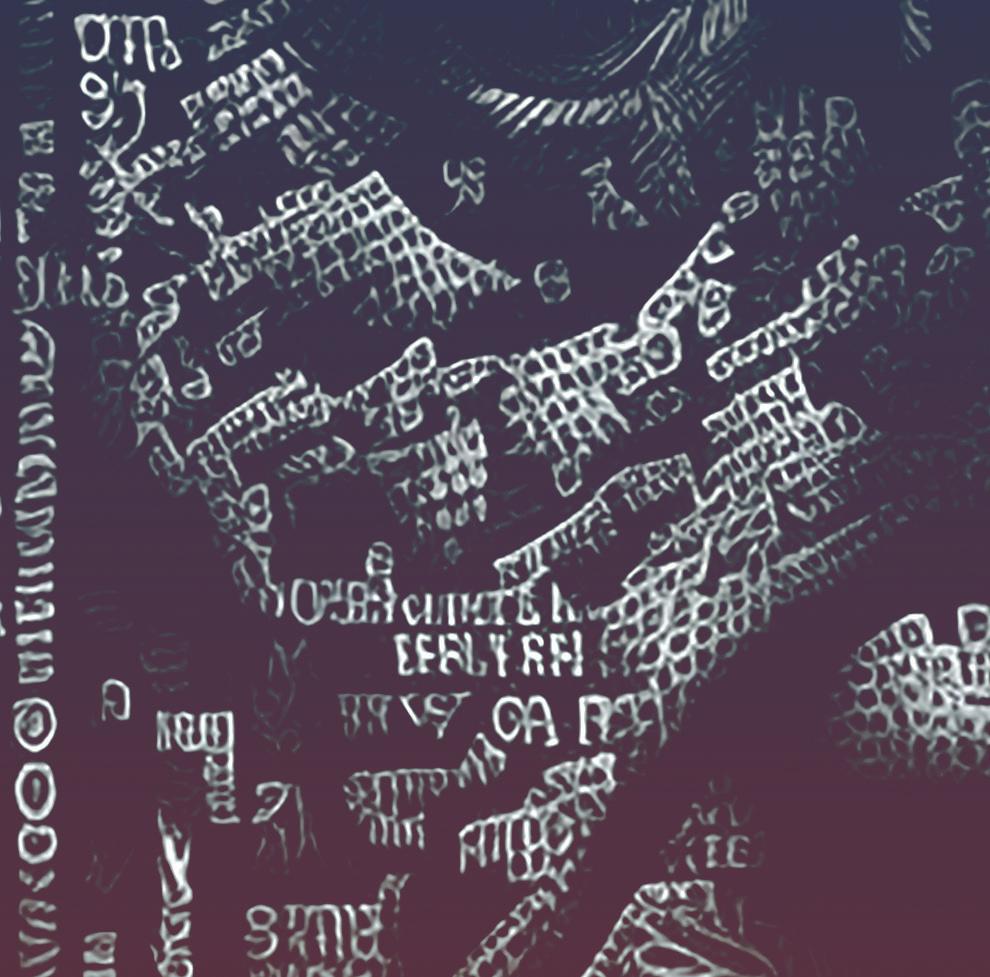






 Collectors Club Philatelist
Collectors Club Philatelist
Noted in Passing on the Auction Block
Matthew HealeyWhat follows are a few notable items from recent auctions that were advertised in the Collectors Club Philatelist. Members who do business with these firms should be sure to thank them for their support of the CCP. If you have spotted – or personally bought or sold—an item you feel is worthy of inclusion in the next round-up, no matter the price, please drop a note to secretary@collectorsclub.org
Ain’t Nothin’ Like the Real Thing
$ 70,800 H.R. Harmer, New York City, The Erivan Collection of the United States, Part VIII, Jan. 17, Lot 2. Advertised in Collectors Club Philatelist Vol. 102 No. 1. Further details at www.hrharmer.com
The New Haven postmaster’s provisional envelopes, locally produced in 1845 in response to the Act of Congress setting standard nationwide postage rates, are among the most famous and revered of the elusive Postmasters’ Provisional issues – in part because most of them have faded over the years. At various times, until it was permanently altered in 1932, the original die for the New Haven stamp was used to make hundreds of reprints, including some with the signature of the original postmaster, sustaining its popular mystique. Only six originals are known, however, and each is unique in either its color or its form. This example, in red ink on light bluish paper with a black signature (Scott 8XU2), is perhaps the finest of the survivors. Freshly certified by the Philatelic Foundation, it comes with an illustrious provenance and last appeared on the market 33 years ago, when the late Erivan Haub acquired it. (Realization includes 18% buyer’s premium.)
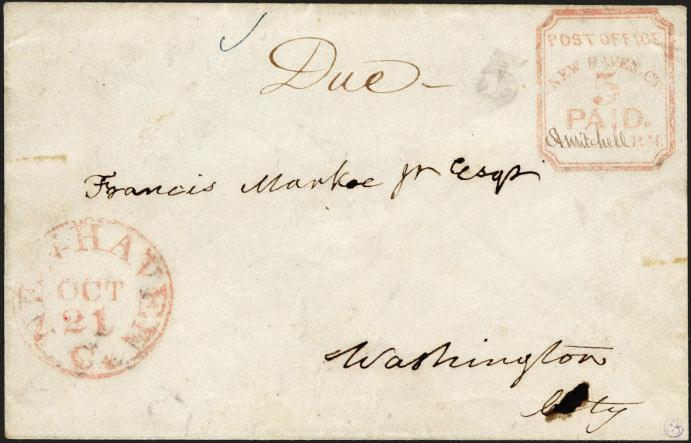
Three Score and Four Square C$ 3,042 Sparks Auctions, Ottawa, Canada, The Athena Collection of Canada, Part 2, Feb. 11, Lot 575. Advertised in Collectors Club Philatelist Vol. 102 No. 1. Further details at www.sparks-auctions.com

In a two-part sale sale brimming with notable Canadian rarities, from the first issue of 1851 to mint and used Seaway inverts and extensive back-of-the-book material, one of the more eye-catching pieces was a used block of four of the $3 yellow-bister from the 1897 Queen Victoria 60th anniversary Jubilee set. Often compared unflatteringly to the U.S. Columbian issue because of the five, dollar-denominated high values serving no particular postal purpose, Canada’s Jubilees are nonetheless attractive and popular among latter-day collectors. The $3 is the scarcest value of the set, with just 13,500 stamps issued. Although by no means a unique multiple – a quick search of Stamp Auction Network revealed the existence of at least half a dozen similar blocks with the same purple Winnipeg cancels – this block is among the better centered and certainly very pretty. (Realization includes 17% buyer’s premium.)
Explore
A Beaver Over Breakfast
C$ 562,875

Eastern Auctions, Bathurst, N.B., The Brigham Estate, Province of Canada, Part I, March 17, Lot 1. Advertised in Collectors Club Philatelist Vol. 102 No. 1. Further details at www.easternauctions.com


Sir Sandford Fleming was a Scottish-born engineer who emigrated to Canada in 1845 at the age of 18. Today, he is remembered chiefly for having been one of the original engineers on the Canadian Pacific Railway, where, among many important contributions, he advocat-
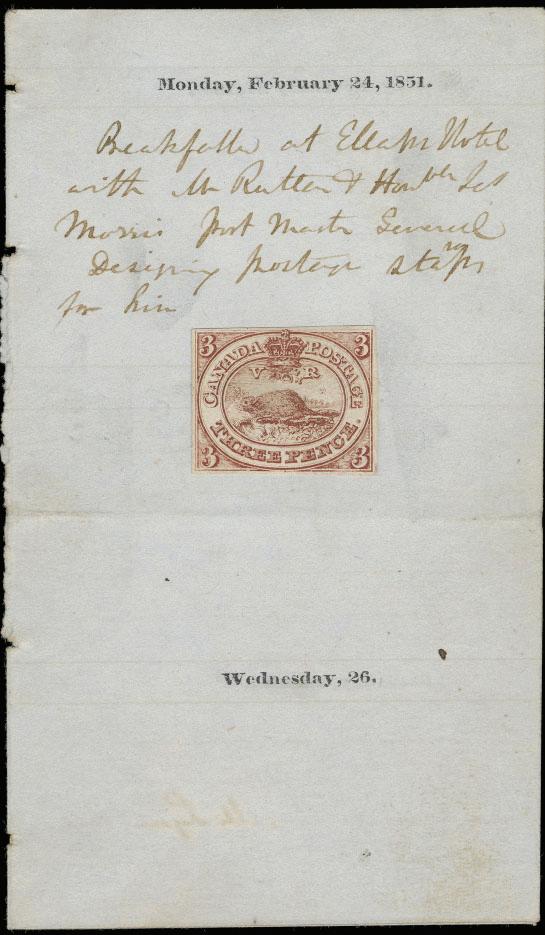
ed building bridges of iron instead of wood. He was also a reformer whose efforts led to the worldwide adoption of standard time zones and the 24-hour clock and, in his spare time, he managed to design Canada’s first postage stamp. A page from Fleming’s diary dated Monday, Feb. 24, 1851, on which he noted having breakfast at a hotel with the postmaster general, bears a charming essay of the 3 pence Beaver prepared by a printer in Toronto at Fleming’s behest. Venetian red in color, the essay differs from the issued version in a number of details, most notably the white oval around the vignette and the somewhat indistinct rendering of the all-important rodent. The late Ron Brigham was only the fourth owner since the Fleming family sold the diary page in 1934. As well as correspondence related to prior sales, the lot included an 18th century print of a beaver at a waterfall that was said to have inspired the design, and a 1950 P.F. certificate signed by Louise Boyd Dale and other experts. (Realization includes 18.5% buyer’s premium.)
Masterpiece Master Proof

C$ 130,350
Eastern Auctions, Bathurst, N.B.: The Glen Lundeen collection of the ‘Admiral’ Issue of Canada, March 18, Lot 501. Advertised in Collectors Club Philatelist Vol. 101 No. 6. Further details at www.easternauctions.com
The so-called “Admirals,” nicknamed for the handsome naval uniform worn by King George V in the vignette, are among Canada’s most beautiful and popular definitive series, having been chased by many of the most famous names in Canadian philately. Lundeen’s collection ranked at or near the top. First issued in 1911, the Admirals were among the earliest stamps anywhere to feature George V upon his accession, and their masterful engraving reportedly impressed the ardent philatelist-king so much that he insisted the stamps of Great Britain feature a similar three-quarter profile. That effort didn’t go so well; the letterpress method could not yield the same

elegant results as this triumph of the line-engraved art. This original master die proof for the Admiral series, which remained current for two decades and utilized some 850 different printing plates, is printed in dark grayish brown and reveals clearly which parts of the stamp design were common to all values and which parts were added separately to each: the leaf stems, the numerals and words of value, the frames containing them and the remaining shading. It is thought to be the only Admiral Issue master die proof in private hands. (Realization includes 18.5% buyer’s premium.)
Halfway ’Round the World for 45¢
€ 915
Heinrich Köhler Auctions, Wiesbaden, Germany, 380th Sale including the Graham Booth collection of Transatlantic mail carriers, Mar. 16-17, 20-25, Lot 9238. Advertised in Collectors Club Philatelist Vol. 102 No. 1. Further details at www.heinrich-koehler.de/en/
Aside from his well-known expertise in British West Indies philately, Graham Booth (1933-2021) was also a student of transoceanic mails. He won two large gold medals at Stockholmia in 2019 – one on the rise and fall of the U.S. Merchant Marine as a transatlantic mail carrier prior to 1870, and one on mail between Britain and Australia. Since his passing, his collections have been appearing at auction with several firms, most recently Heinrich Köhler in conjunction with H.R. Harmer. The cover shown here managed to encapsulate aspects of both of Booth’s award-winning passions. Posted in 1864 in Washington, D.C., it traveled first to New York City, then crossed the Atlantic on a British steamer to London, whence it continued on its way via Marseille and Alexandria to Australia. Forty cents of the three-color 45¢ franking was credited to Britain for the long voyage across two oceans, which took two months to complete. An altogether remarkable cover from a remarkable bygone era. (Realization includes 22% buyer’s premium.)

The Volcanoes of El Salvador € 2,928


Heinrich Köhler Auctions, Wiesbaden, Germany, 380th Sale including the Michael Peter collection of El Salvador, Mar. 16-17, 20-25, Lot 1774. Advertised in Collectors Club Philatelist Vol. 102 No. 2. Further details at www.heinrich-koehler.de/en/

El Salvador may not be the most widely collected Latin American country, but it obviously has its adherents. Despite being the smallest mainland nation in the Americas, its philately rivals the greatest, both in stamp production and in postal history. This is evident in the material assembled by Michael Peter, who passed away in 2020 at a relatively young age, but left an important legacy, having chaired the Latin American Collectors’ and Study Group and coauthored a handbook on Salvadoran postal history. The collection offered by Köhler ranged from pre-stamp postal history to early adhesives on cover, along with extensive die proofs of Salvadoran stamps engraved by various bank note firms in the United States. The registered, double-weight cover shown was sent via London to Germany (a source of substantial immigration to El Salvador) in 1883; Köhler described it as the only four-color franking reported from this country. (Realization includes 22% buyer’s premium.)

Montevideo Tête-Bêche
$ 300,900
Robert A. Siegel Auction Galleries, New York City, The Magnolia collection of classic Uruguay (Sale 1279), Mar. 28, Lot 49. Advertised in Collectors Club Philatelist Vol. 102 No. 1. Further details at www.siegelauctions.com
Philately loves a snafu, and none more so than some kind of invert. Before bicolor printing was commonplace, inverts could occur when one cliché in a plate was entered upside-down in relation to its neighbors, resulting in a tête-bêche pair or block. Separated, of course, such an invert loses any significance; its rarity therefore rests entirely on the preservation of some multiple. During philately’s classic period, that tended to be the exception rather than the norm. The first issue of Uruguay, dating to 1858, produced tête-bêche errors on both the 120c and 180c values. They rank among the aristocrats of classic philately, with only a couple of each surviving. This horizontal pair of the 180c, ex Ferrary, Lichtenstein et al., is the only one in private hands; a vertical pair resides in the Tapling Collection in the British Library. Alfred Lichtenstein showed this one as part of his collection at the 1940 centenary exhibition held at the Collectors Club. The appropriate page from that exhibition catalog is shown nearby, with this pair marked by an arrow. (Realization includes 18% buyer’s premium.)
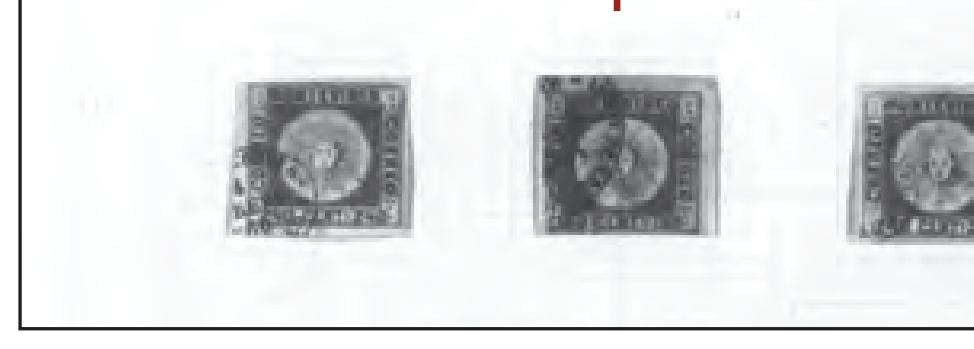



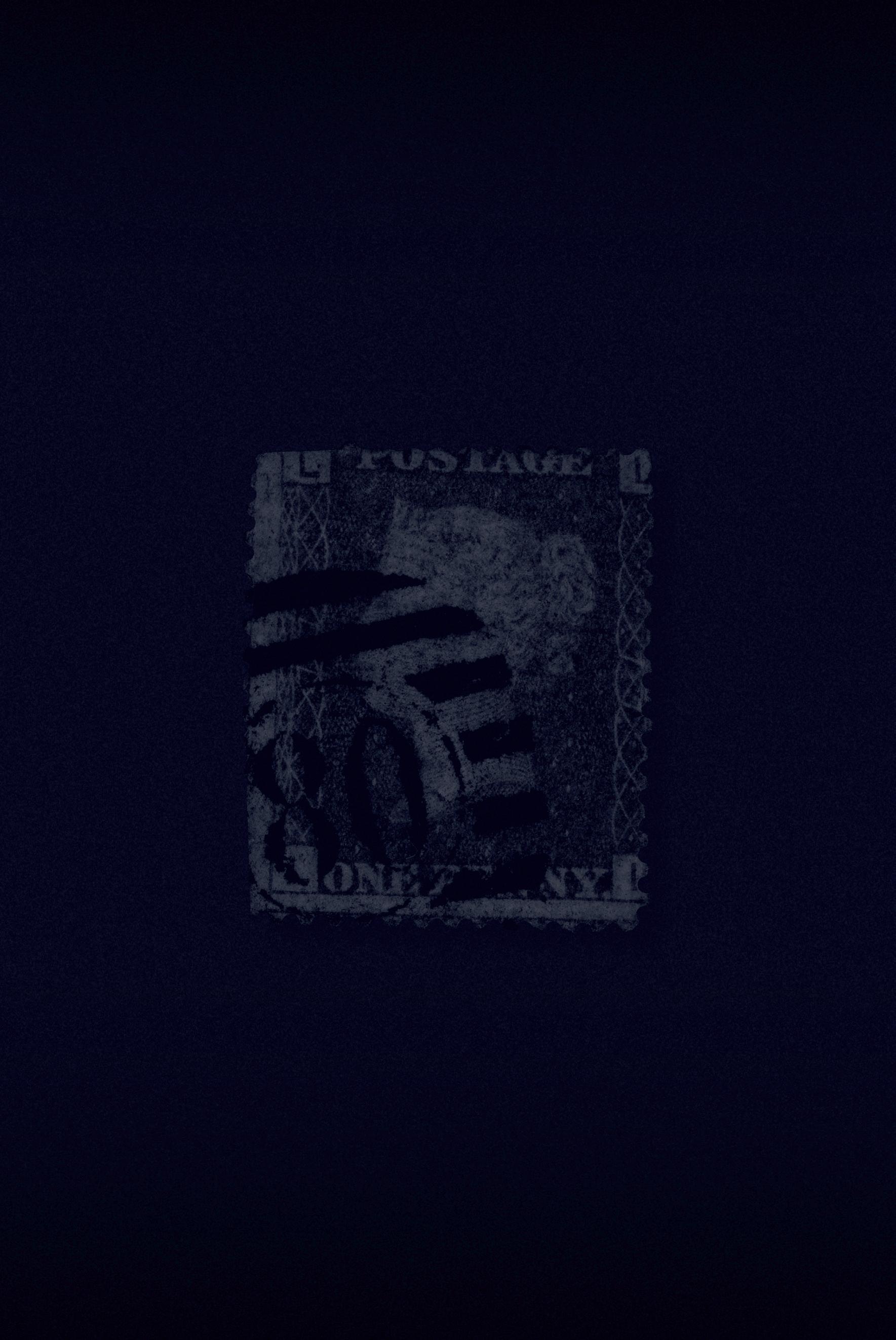

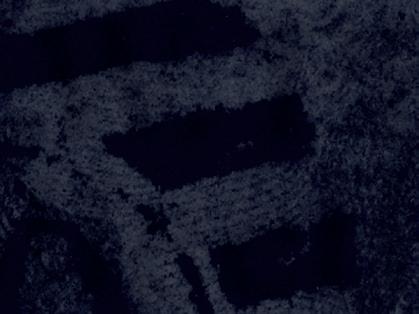

Book Reviews
Richard T. Hall, The Swiss National Exhibition 1939 – The “Landi” Volume 1 – The Philatelic Aspects, hardcover, ISBN 979-8362203825, 129 8¼- by 11-inch pages, Exhibitors Press, 2022, $45, available from Amazon.
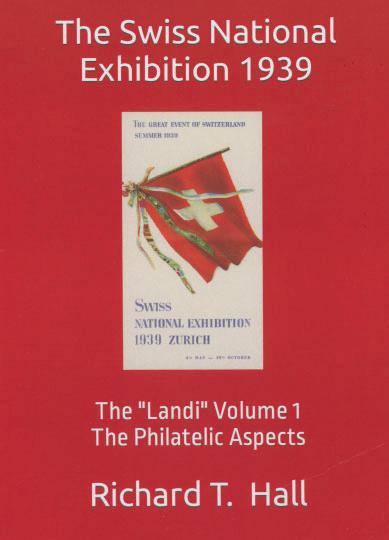
The Swiss National Exhibition was held on the banks of Lake Zürich over the course of six months in 1939. Originally organized to highlight Swiss culture and commercial products for export, the run up to World War II gave it an additional political and nationalistic purpose: to unify the Swiss population to support Switzerland’s defense from foreign aggression. In this volume, the author explores all the philatelic aspects related to the exhibition, serving as a guide to both collectors and postal historians.
Opening chapters present the advance promotion of the exhibition through the use of machine slogan cancellations, postal meter slogan and a series of nine stamps with legends in the three main Swiss languages (German, French and Italian) during the year ahead of the exhibition’s opening day. A detailed table of cancellation usage periods and printing data are accompanied by stamp uses and detailed illustrations of a selection of printing flaws.
A narrative history of three multi-stop promotional flights, “Europa” South, North and West, to a total of 22 leading European cities with accompanying maps, photographs and flight cover illustrations is also presented.
A description of the postal services provided by the four post
offices within the extensive exhibition grounds is followed by a presentation of the 12 additional exhibition stamps issued in both sheet and se-tenant coil formats on the opening day of the exhibition. Detailed production data, a guide to distinguishing stamp types, printing varieties and postal history examples are shown and explained.
Several dozen varieties of illustrated postal cards and lettersheets were prepared and sold at the exhibition and are given extensive coverage, with reproductions of the various illustrations, technical printing notes and interesting usage examples.

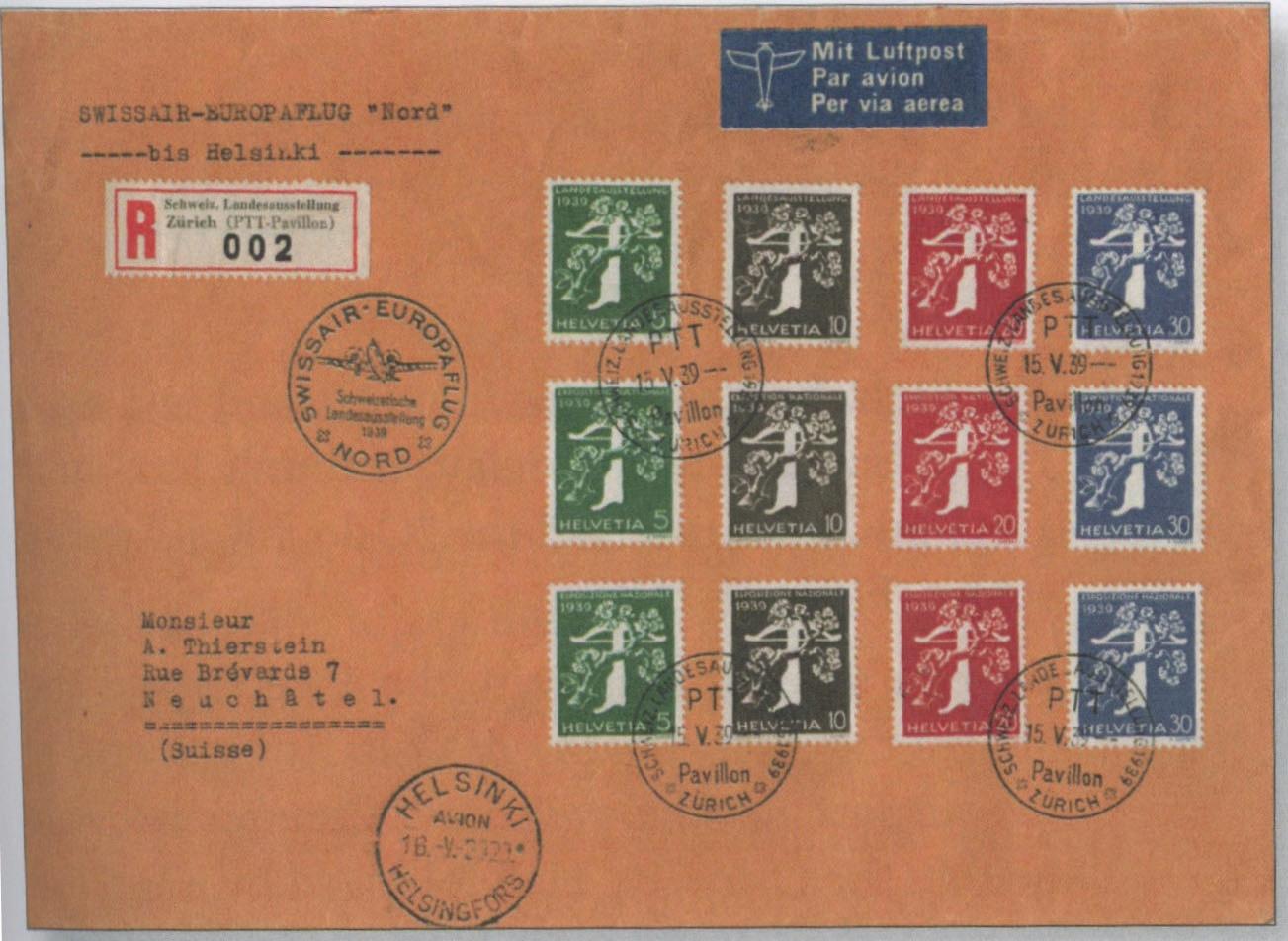
During the opening-day ceremonies on May 6, a squadron of Swiss Air Force Fokker CVE aircraft flew in formation and then 11 of the planes peeled away to deliver commemorative flight covers to 25 cantonal destinations. Documentary photographs, maps, tables and illustrations of covers are shown. Eight days later, an international balloon competition was held, accompanied by a non-competitive mail balloon piloted by prominent Swiss balloonist Fred Dolder. An account of the exciting flight of the Italian team’s balloon is best left to the reader to enjoy.
As a final bonus, the book includes a 16-page translation of Remi Kohler’s fully illustrated study of printing flaws on the Crossbow and Blooming Branch stamps issued on opening day.
Additional volumes exploring Planning and Construction (Vol. 2), Events and Activities (Vol. 3), and Tours of the Pavilions on the Left Bank (Vol. 4) and Right Bank (Vol. 5) are in preparation. Reflecting the comprehensive philatelic treatment in Volume 1, these promise to complete a landmark review of one of Switzerland’s greatest social events of the mid-20th century.
Bruce MarsdenRaymond J. Burby, Natural Disasters on Postage Stamps; A Guide for Collectors, 324 pages, plus card cover, perfect bound, 6- by 9-inch pages, color illustrations throughout, ISBN 978-0-578-27106-4, published by the author, $70 plus shipping (Media Mail). Contact: burby@email.unc.edu
It makes sense that a book covering the stamps of the world that feature or depict natural disasters would be written by an expert on natural disasters. Raymond Burby is internationally known for his work in public policy to reduce losses due to natural disasters, and has written many books on the subject. It also happens that Burby is a stamp collector – and an apparently very well organized one at that!
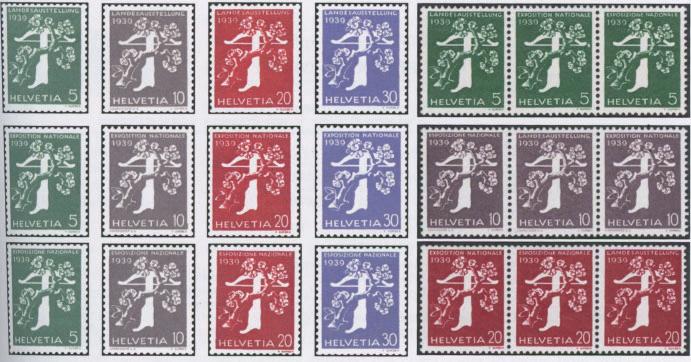
“People the world over are fascinated by natural disasters,” Burby opens with his preface. “Disasters showcase the amazing power of natural forces, the precarious situations of the communities in which many live, the courage of those who fight them and the fortitude of people who suffer them.”
Its takes no imagination, then, to realize that multitudes of natural disasters have been depicted on stamps, as well as hundreds of related services, victims, tools and more. But why enumerate them here, when I can share a portion of Burby’s contents.
His book is separated into seven primary categories, including natural disasters on stamps, stamps and hazard assessment, stamps and disaster response, international aid on stamps, postal services in disasters, postal services in relief and loss reduction on stamps. The time period covered includes virtually everything from the Great Biblical Flood through 2012, and each is separated by category.

So, if you are interested only in the disasters themselves, you’ll find sections for cyclonic storms, droughts and famine, earthquakes, floods and tsunamis and volcanic eruptions, and each of these subcategories is broken down chronologically.
For example, if you are interested in the 1906 San Francisco earthquake and fire, you can turn to page 39 for a short synopsis of the event itself, as well as a picture postcard and a 1988 stamp from St. Lucia (Scott 923, shown nearby) that depicts damage from the quake (the St. Lucia stamp was actually issued to commemorate the 300th anniversary of Lloyd’s of London, but shows a scene from San Francisco). The same organizational style is true for each of Burby’s other categories.
The downside of this type of book is that it is – in no way – comprehensive (it really cannot hope to be), but can serve as a springboard for beginning any number of interesting related collections and is interesting to read.
Two other points must be noted, as they relate to collectors. The quality of many of the images throughout suffers from poor resolution. Also, a number of the events he references are not necessarily illustrated with postage stamps; quite a few show picture postcards instead. He does feature an index – by country – of the disasters depicted and on what page they can be found. Still, this is a very helpful guide to some of the materials available for the interested and tenacious collector.
— Wayne L. Youngblood
Ketty
Vol. 0, The History, 104 pages, and Vol. 1; 232 pages, La Serie – The set; color illustrations throughout, €40 for Vol. 1 [Vol. 0 free] + postage (bank wire transfer accepted), available from enciclopediacastelli@gmail.com
(8¼”
Since the early 1970s, Italian definitive series have become very popular with Italian collectors for many reasons, including ease of finding the basic material and stamps to lay the foundation of the collection, as well as paying attention to any developments regarding the tariffs, varieties, frankings of special interest, counterfeits to defraud the post office, change of currency, combination frankings, paper and watermark varieties, as well as perforations, gum and ink types and nuances.
The “Castles” definitive has enjoyed popularity in Italy and abroad; the reason for this is the possibility of retrieving mail sent to foreign countries, as well as domestic mail and specialist items to give in exchange to foreign collectors. When you see stamp collectors on Facebook you will notice that most have friends and contacts all over the world. That’s called collectors’ fun.

The co-authors of this specialized encyclopedia have great enthusiasm and great plans. To begin with, their project is expected to have an additional five or six volumes over time. This is possible due to the large number of articles published in Italy and the collaboration of enthusiastic collectors. The authors themselves have written extensively about this definitive series and have been able to build remarkable collections.
Some 52 face-different stamps have been issued for the “Castles” definitive –the fifth definitive of the Italian Republic; some 27 stamps were issued initially
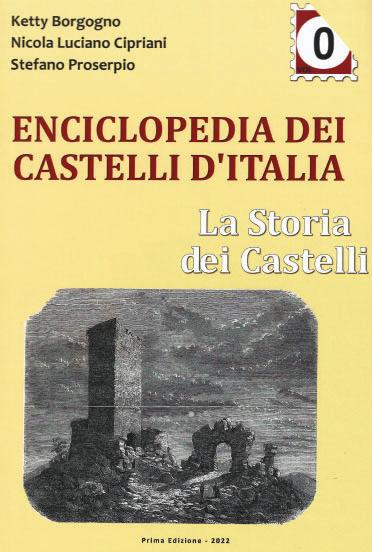
and, by popular demand, some 25 additional castles were welcomed by collectors. The historic importance of these castles is a great catalyst for both collectors and history enthusiasts. The definitives that preceded were the Democratica, Italy at Work, the Siracusana and the Michelagiolesca: the first three redundant with rhetoric aimed at reunifying the population and restoring democracy, peace and brotherhood. The Michelangiolesca restored the Italian pride stemming from great artistry and endless talent of Italian geniuses. What was missing in some form was something to make grassroots postal users even more proud of their native land, region, district and town – this was certainly achieved by the Castles definitives. In simple words, it awoke civic awareness and pride.
On the practical side, we must join the authors when they state that the 52 stamps responded to the demand of specific denominations that were needed to cover the tariffs of as many services provided by the postal service.

The siblings generated by this definitive include stamps for vending machines, postal cards, lettercards and a special postal card for the national stamp exhibition “Cosenza 1986.”
Volume 0 of this encyclopedia includes a detailed profile of each castle featured in this series.
Volume 1 gets down to the basics as it examines the various phases and aspects ranging from the issued stamps, the artwork created for each stamp, the engravers, the printing proofs, die proofs, color proofs, the subject, postal stationery (official and privately issued), the ministerial decrees, the ministerial bulletins, maximum cards, first-day covers, first-day postmarks, special events postmarks, cinderellas, cards and strange and odd items.
The three courageous musketeers working on this encyclopedia have certainly enthused both veterans and newcomers; the bibliography is so vast that you will find most answers to your questions. My review of Danilo Bogoni’s monograph published in 1999 by the Ministry of the Posts is one of the most-read entries of mine on Academia.edu. This new encyclopedia will certainly fuel great interest; these two volumes will whet your appetite for those upcoming. In concluding, I must praise the choice of the authors in placing the contents page at the beginning of the volumes, which are a pleasure to handle, being very well produced on high-quality paper.
— Giorgio MigliavaccaThe Collectors Club
Membership Update: Feb. 28, through April 20, 2023.
Spelling Correction: Sobon, Paul
We apologize for the misunderstanding.
Approved by the Board of Governors: March 28, 2023
No pending applications.
Congratulations to our new members. A membership certificate will be forwarded to the address on file for each. Please keep us updated as to your current address and email so that we can continue to serve you. Electronic outreach is increasingly important, as we continue to expand our offerings. Our website (www.collectorsclub.org) receives ongoing enhancements based on member feedback. Please contact us at info@collectorsclub.org with feedback, comments or questions.
Dues notices for 2023 have been sent to members’ email addresses. If we do not have a current, or valid email address, an invoice will be sent by mail. If you would like to update your contact information, please contact Executive Secretary Andrea Matura at: info@collectorsclub.org.
We regret that membership “drop notices” will be sent out after an additional outreach to members who have not renewed for 2023.
Please advise our office of address changes or other membership updates in a timely manner at info@collectorsclub.org
Respectfully submitted,
Mark E. Banchik, Membership Co-Chair Lawrence Hunt, Membership Co-ChairPlease Remember ...
Those who advertise in the Collectors Club Philatelist are supporting both our organization and the hobby in general.
If you purchase stamps or covers from these fine companies, please let them know you saw their ad in the CCP.
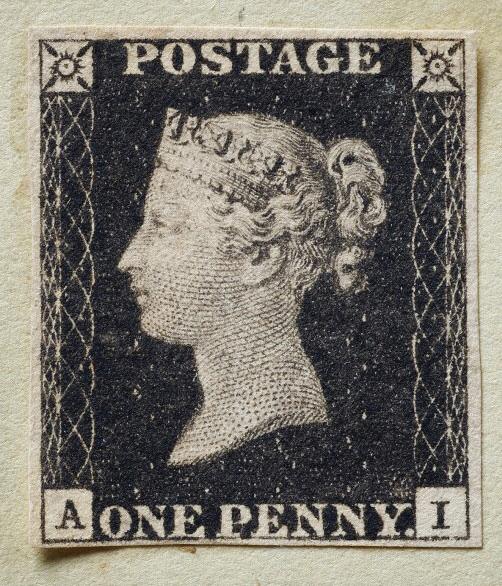

Please Remember ...
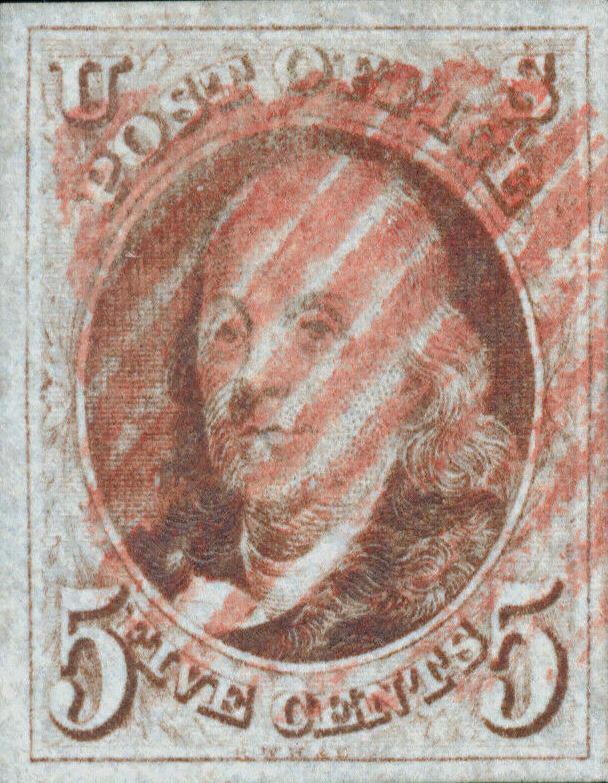













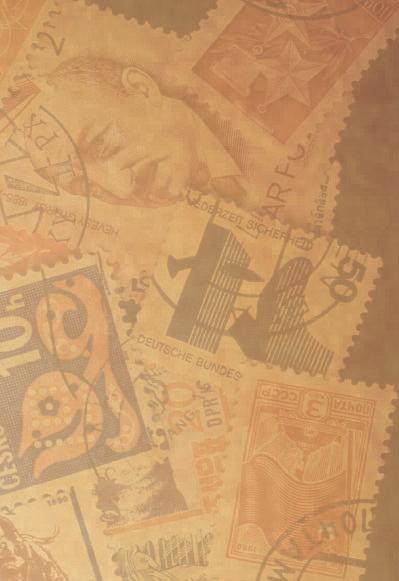
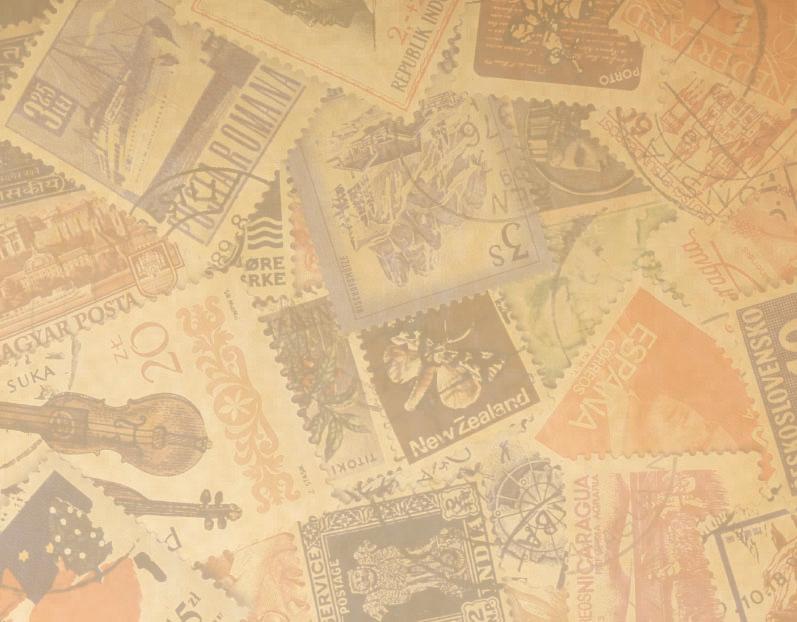
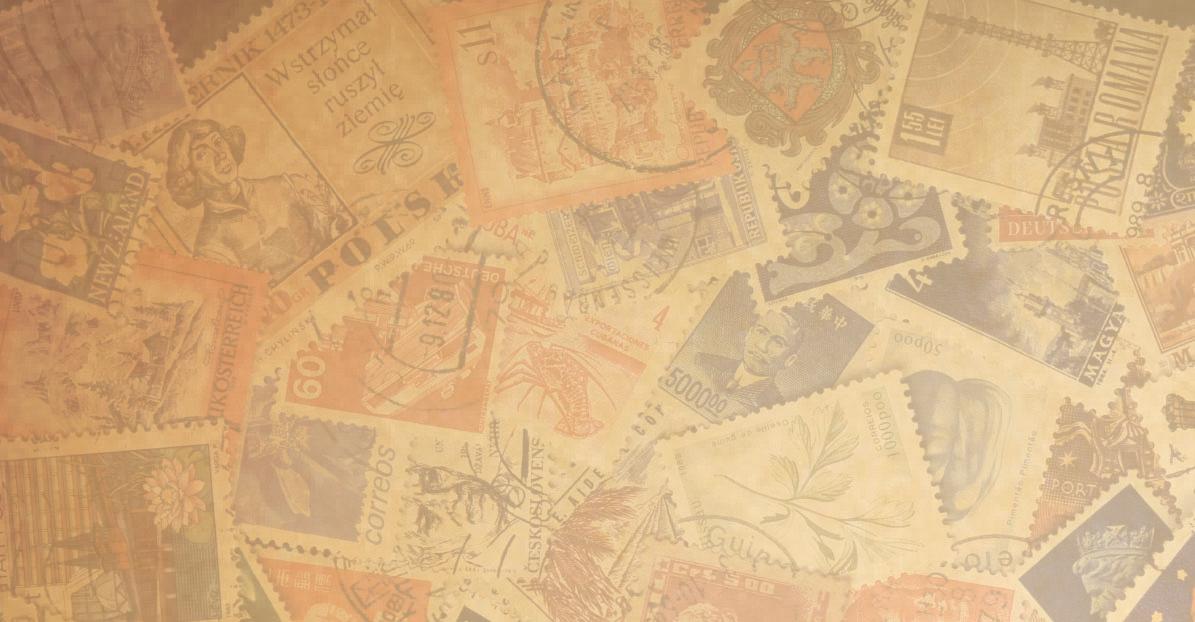
SCHUYLER J. RUMSEY AUCTIONS IS PROUD TO ANNOUNCE THE SALE OF:
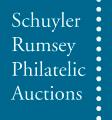
THE DR. MANUEL CESAR IGLESIAS COLLECTION OF MEXICO
This important collection will be offered in the of Fall 2023
The Dr. Igelsias Collection of the Mexico features the 1856 and 1861 Hidalgo Issues and is one of the finest ever formed. There is virtually every district present, both on and off cover, with a stunning array of cancellations. Visit our website for coming information regarding this exciting auction.

415 781 5127 srumsey@rumseyauctions.com visit us at www.rumseyauctions.com

2023 RARITIES OF THE WORLD



